Can You Bring Baby Formula On A Plane? (Powder vs Liquid TSA Rules)
Last Updated on August 7, 2022
So you want to know how to travel with formula…
How much formula can you take? And how should it be packed when going through the airport security checkpoint?
Let’s find out quickly before your baby needs fed or a nappy needs changed!

TSA Baby Formula Rules
The Transportation Security Administration runs airport security. They decide what you can and can’t take on a plane.
Here’s a screen-grab from their website about flying with formula:
Note the special instructions for bringing baby formula in carry-on luggage.
Here’s the deal. The instructions are a little different for baby formula powder and premixed liquid formula.
Flying With Powered Baby Formula
You can bring powered baby formula on a plane in your carry-on bag or checked bags.
But when packing powdered formula in hand luggage the powders rule applies.
There is no limit to the amount of powdered baby formula you can pack in your carry-on luggage.
But if your powdered can is over 12 oz then remove it from your carry-on bag and place it in a separate tray when going through security so it can undergo additional screening.
It doesn’t matter if your baby’s formula is opened or unopened.
Flying With Liquid Baby Formula Or Water
You can also bring bring premixed liquid formula or water to mix with your powdered formula. The usual 3.4 oz liquids rules does not apply and you don’t need to pack the liquid in your quart sized bag.
The same goes for bringing breast milk in carry-on baggage.
You can also bring formula cooling accessories like ice packs, freezer packs, or frozen gel packs.
So you can cool formula bottles with an ice pack when traveling. Once you are on the plane you can ask a flight attendant for hot water to get your baby’s meal back up to a temperature they will enjoy.
Your baby does not need to be present when going through security (but it helps). In theory you just need to explain to the TSA officer at the checkpoint that you are bringing the water or liquid formula as a medically necessary liquid for your baby.
When an infant is old enough to walk through security unaided they are no longer considered to be an infant by the TSA and this exception to the usual liquids rules no longer applies.
It’s recommended that you transport any liquid baby formula in a clear translucent bottle to help with the screening process.
Liquids stored in plastic bags or pouches can’t be screened by the bottle liquid scanners so you might be asked to open them.
X-ray machines don’t negatively impact formula or breast milk but if you don’t want the TSA to use them you can ask that they are screened separately the liquid using other methods.
How Much Formula Can You Take On A Plane?
Since medically necessary liquids are exempt from the usual liquids rules there is no limit on how much you can bring.
The same goes for powdered baby formula. There is no limit to how much formula you can take on a plane.
So you won’t have any problems with reasonable quantities in carry on bags.
You airlines carry-on luggage size limits do still apply. So check with your airlines if you are bringing a diaper bag in addition to your carry-on suitcase.
Some low cost airlines don’t permit you to bring two bags into the cabin.
The Verdict
When flying with baby formula or baby food the regular security rules don’t apply.
The TSA is sensible enough to know that parents traveling need to always be able to bottle feed their baby and so baby formula is considered medically necessary.
Quantities greater than 3.4 ounces are permitted for liquid baby formula, and their is no limit on how much powdered baby formula you can bring. You can even bring water for babies too!
Happy flying!
Did This Page Help You?
You might also like.
- Can you wear your baby through the security checkpoint?
- How soon can a newborn baby fly?
How Can We Fix The Page?
Please let us know how to improve the page we'll try to fix it.
There Were Errors On The Page It Was Missing The Information I Needed
Tell Us More...
Your Name (required)
Your Email (required)
Great! We Aim To Please!
Maybe you can help us.
Social shares allow us to continue to publish more articles so if you can help out by sharing it would be much appreciated!
Flying with breast milk or formula? Don't worry about liquid limits. Here's what to know.
Actress Keke Palmer called out airport security officers in Houston this month on Twitter , saying they threatened to throw out more than 16 ounces of breast milk as she was going through security.
The officers were unambiguously in the wrong if they did ask her to get rid of her breast milk.
A Transportation Security Administration spokesperson told USA TODAY the agency was not aware of the incident but said travelers are encouraged to submit comments and concerns to the agency directly if they encounter issues during their screening.
TSA regulations make generous allowances for milk and formula:
Formula, breast milk, toddler drinks, and baby/toddler food (to include puree pouches) in quantities greater than 3.4 ounces or 100 milliliters are allowed in carry-on baggage and do not need to fit within a quart-sized bag. Formula, breast milk, toddler drinks, and baby/toddler food (to include puree pouches) are considered medically necessary liquids. This also applies to breast milk and formula cooling accessories, such as ice packs, freezer packs, and gel packs (regardless of presence of breast milk). Your child or infant does not need to be present or traveling with you to bring breast milk, formula and/or related supplies.
Travelers can also notify the TSA if they plan to travel with medically necessary liquids.
Nikeytha Ramsey, founder and CEO of Junobie, a company that produces sustainable, plastic-free storage containers for breast milk and baby formula, said it’s important for parents to know their rights when they fly with such liquids and to stick up for them if they run into any problems.
“It says it right here on your website that I am allowed to fly. Breast milk does not count against the 3.4-ounce rule. Neither does baby formula,” she said. “So just like what your website says ... I would appreciate if you can honor this right now for us.”
Ramsey added that it’s usually a good idea to notify TSA agents about any breast milk or formula you may be traveling with before your screening starts.
“You never know what TSA agent you are going to get. You can get a really, really pleasant TSA agent and they're not going to really give you any issues,” she said. “I will inform TSA, ‘Hey, I do have breast milk,’ or if you are a parent that has baby formula or baby food, inform them that you do have these things. That's what I always do. And they will take it over to either the bottle X-ray to screen it, or they will do what we call a vapor test.”
Tell us your story: Mobility device lost or damaged by an airline? USA TODAY wants to hear about it.
Sens. Tammy Duckworth, D-Ill., Mazie Hirono, D-Hawaii, and Steve Danes, R-Mont., reintroduced legislation in May that would require the TSA to better educate its officers about its policies, citing reports from constituents of complaints similar to Palmer’s.
“Too often, I hear stories of traveling moms being mistreated and denied access to their breast milk and the breastfeeding equipment that they need to pump and feed their babies,” Duckworth said in a statement . “Many of these incidents are inconsistent with TSA’s screening policies, which is why I’m proud to reintroduce this bipartisan legislation to ensure TSA keeps its employees up to speed on their own policies and updates those policies as necessary. It’s the least we can do to help make sure parents traveling through our airports are given the respect and dignity they deserve.”
The Bottles and Breastfeeding Equipment Screening Enhancement (BABES) Act would require the TSA to:
- Issue guidance promoting the hygienic handling of any breast milk, baby formula or other infant nutrition products, as well as accessories traveling through checkpoints.
- Consult with nationally recognized maternal health organizations in establishing and communicating the guidance to officers and travelers.
- Update its guidance every five years to respond to the emerging needs of parents and to account for developments in technology.
For now, the TSA recommends traveling with breast milk or formula in clear, translucent bottles rather than in bags, which can be harder to screen.
Travelers should know their rights when flying with breast milk, formula or related devices, and they can check out the TSA’s full guidelines linked again here .
Contributing: Ariana Triggs, USA TODAY
Zach Wichter is a travel reporter for USA TODAY based in New York. You can reach him at [email protected]

TSA Formula Rules: How to Travel With Breastmilk and Formula

We are proud to say that these posts are not sponsored. Our editorial team of Bobbie moms and writers personally select each featured product. If you buy something through our links, we may earn an affiliate commission, at no cost to you.
Avoid the dreaded security line milk dump with these tips from a travel pro and mother of two.
Flying with babies is stressful, even if they miraculously spend most of the flight sleeping. Luckily, one thing you don’t need to worry about when it comes to air travel is whether you can bring enough baby formula or breast milk to keep your baby happy and well-fed throughout your trip.
While passengers are usually allowed to bring a maximum of 3.4 ounces [100 mls] of liquid in their cabin luggage, that rule doesn’t apply to milk and food for infants and young children. Breast milk and formula are considered medically necessary liquids. This also applies to breast milk pumping equipment. You do not need to travel with your child to bring breast milk.
- Tips from a travel pro and mother of two
The Formula Mom’s expert tips on traveling with baby formula
How much baby food can i take on a plane, inspections, what to expect with baby formula, don’t be afraid to advocate, rules vary based on your destination.
We spoke to Mallory Whitmore, aka The Formula Mom. Her biggest piece of advice? You can chat with TSA via iMessage ahead of your trip to ask questions. The benefit is that you have a record of their response if you need to reference it with them during travel! To reach them, visit TSA customer service online. Under “Ask TSA” select “Apple Messages”— it opens a text thread! For android users there’s the option to use FB messenger.
Experienced travelers know that snacks, and lots of them, are key to keeping kids relaxed mid-flight. Extra feeds can be a great source of comfort for babies in unfamiliar surroundings, too. That’s why we suggest packing twice as much milk as you think your baby will need, even if you’re taking a very quick plane trip.
Doubling up when flying with breast milk will reduce the stress of any unexpected delays, annoying spills, long lines, or lost luggage upon your arrival. It’s always better to be prepared.
Formula, breast milk, juice, and baby foods in quantities greater than 3.4 ounces [100mls] are allowed in carry-on baggage and don’t need to fit in a quart-sized bag.
According to Transport Security Administration [TSA] guidelines, you’re permitted to bring larger amounts of breast milk and baby formula in reasonable quantities for your trip.
Security screening officers have the final say on what’s considered “a reasonable quantity,” but they’re unlikely to bat an eyelid at an entire carry-on bag full of baby food. This can include items like:
- Your baby’s milk of choice
- Sterilized water
- Food in liquid, gel, powder or paste form (like yogurts and purees).
Bobbie mom, Angela, shares her tips for traveling with baby formula: Bring formula water in your thermos and make sure it’s in your diaper bag! The key is to keep everything in your diaper bag so it’s very clear for the TSA that it’s for your baby.
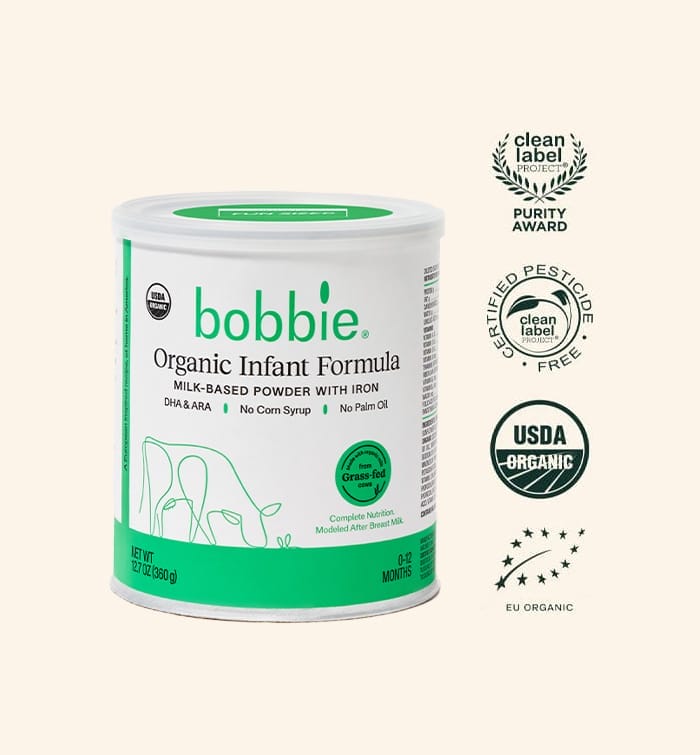
Shop Bobbie Organic Infant Formula
Bobbie Organic Infant Formula is a USDA Organic, EU-style infant formula that meets all FDA requirements. It is a complete nutrition milk-based powder modeled after breast milk and is easy on tummies. It is non-GMO and doesn't have corn syrup, palm oil, or maltodextrin. Learn more about Bobbie.
Quick Summary
- TSA guidelines allow flying with breastmilk and baby formula in reasonable quantities.
- You can double the amount your baby will typically consume during travel, and this will likely still fit into the screening officers’ “reasonable quantity” guideline.
Everyone wants to get through airport security as fast as possible. So how can you avoid any hurdles with your milk stash?
Declare your baby’s milk and foods to security officers at the beginning of the checkpoint for inspection. Then, remove them from your carry-on bag to be screened separately from the rest of your stuff.
You don’t need to be traveling with your baby when transporting breast milk. You may be asked to open any milk bottles for further inspection as liquids are typically screened by X-ray. If it’s feasible, you could also be asked to transfer a small quantity of milk to another container or dispose of a small amount.
The Food and Drug Administration (FDA) states that there are no known adverse effects from eating food, drinking beverages and using medicine screened by X-ray.
- You will need to remove formula, breast milk and juice from your carry-on bag to be screened separately.
- Food, beverages and medicines screened by X-ray are safe to consume.
- You don’t need to be traveling with your baby to carry formula or breast milk on a plane.
If you’re not comfortable having your baby’s formula, breast milk or baby food X-rayed or opened, you’re well within your rights to decline.
The TSA formula rules state that additional screening steps can be taken to clear your liquids, such as a pat-down and further screening of your other carry-on luggage. If your breast milk is frozen, a visual inspection is usually sufficient.
Once on board, most cabin crew won’t mind warming up your baby’s milk or food during your flight. In our experience, it’s often too hot when you get it back, so try to plan for extra time to cool it back down to a suitable temperature and give it a quick rub with an anti-bacterial wipe before feeding it to your baby.
Ice packs, freezer packs, frozen gel packs and other accessories used to cool formula, breast milk and juice are allowed in your carry-on but may be subject to additional screening if slushy or partially frozen. You can also bring gel or liquid-filled teethers.
Quick summary when it comes to traveling with baby formula
- You can decline to have your baby’s food X-rayed or opened for inspection, but you may have to undergo additional screening.
- If you have the cabin crew warm your baby’s meal, check the temperature and sanitize the bottle before giving it to your baby.
- Accessories used to cool your baby’s food are allowed in your carry-on but may be subject to additional screening if they’re not fully frozen.
Rules can vary from country to country, so be sure to research what’s permitted at your specific travel destination. Airport websites are usually a great place to find everything you need to know about what you can and can’t bring for your baby.
For additional tips on feeding your baby while on the go, the following blog posts are a great source of information:
Formula feeding and breastfeeding— Can you do both? Can you use tap water for baby formula? Does baby formula need to be warm?
The content on this site is for informational purposes only and not intended to be a substitute for professional medical advice, diagnosis or treatment. Discuss any health or feeding concerns with your infant’s pediatrician. Never disregard professional medical advice or delay it based on the content on this page.
- Getting started with formula
- Breastfeeding
- Combination feeding
- Feeding Confessionals
- Expert Insights
- The Formula Mom
- Shop Bobbie Organic Formula
- Milk Drunk Podcast

Flying with Your Baby: How to Travel With Baby Formula on a Plane
Aug 24, 2023
Share this article
“Embarking on a journey with your little one is a cherished adventure, full of joy and new experiences. Yet, when it comes to jet-setting with your precious bundle and ensuring their nourishment on the go, the path might seem a bit more complex.
Fear not, intrepid parents, for in this guide, we unveil the secrets to a seamless voyage– From deciphering security protocols to crafting in-flight feeding strategies, join us as we navigate the skies together, making every mile-high moment a memory to treasure
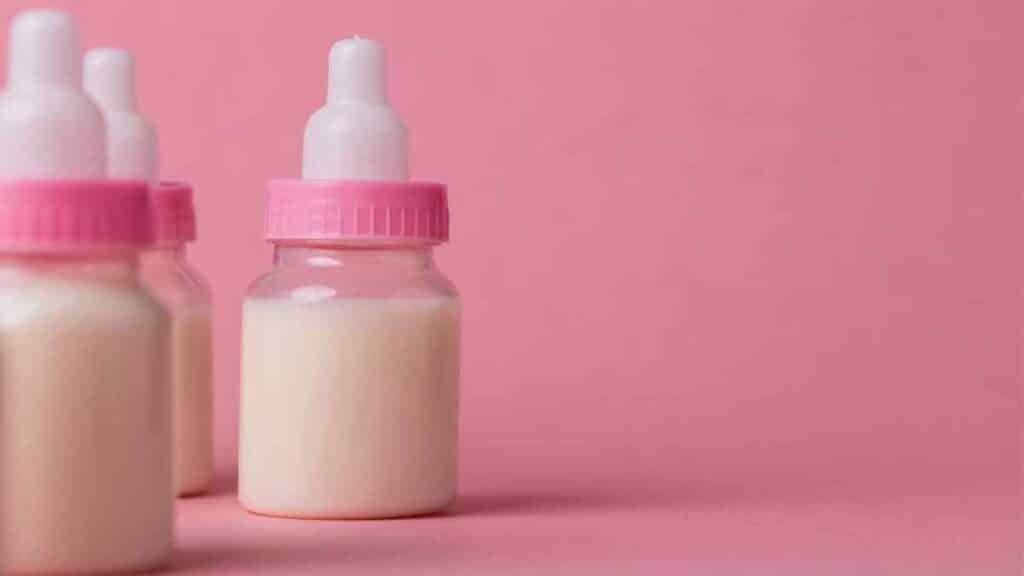
Preparing for Travel
Traveling with a little one in tow is an exciting endeavor, but it requires meticulous planning, especially when it comes to ensuring your baby’s nourishment. If you’re a parent who is navigating the world of flying with baby formula, fear not! In this column, we delve into the essential steps of preparing for travel, from understanding airline policies to calculating the right amount of formula needed for a smooth journey.
Researching Airline Policies and Regulations
Before you even set foot in the airport, take the time to research your chosen airline’s policies and regulations regarding traveling with baby formula bottle packs. There are crucial aspects to consider:
1. Security Regulations and Restrictions: Security measures are paramount in air travel. Be prepared for your baby formula to undergo additional screening procedures at security checkpoints. Inform the TSA officers that you’re carrying baby formula, whether it’s ready-to-feed formula, powdered formula, or breast milk. These liquids will need to be screened separately from the rest of your belongings, so ensure they are easily accessible.
2. Liquid Carry-On Rules: As a general rule, liquids are subject to restrictions, but there are exceptions for medically necessary liquids. This includes baby formula, breast milk, and baby food. While you’re allowed to bring breast milk, formula, and baby food in reasonable quantities, it’s important to note that these items do not need to fit into the quart-sized bag required for other liquids. However, you may still consider placing them in a translucent bag for easy identification.
Checking Destination Regulations
When preparing for international travel, it’s equally important to be aware of regulations and cultural considerations at your destination:
1. International Regulations: Different countries may have varying regulations concerning baby formula and other baby-related items. Some places may require special documentation for formula or breast milk. Research your destination’s customs and regulations to avoid any surprises upon arrival.
2. Cultural Considerations: Beyond regulations, consider cultural norms and practices at your destination. This is particularly crucial when it comes to breastfeeding or formula feeding in public. Understanding cultural sensitivities will help you navigate feeding your baby comfortably during your trip.
Calculating the Amount of Formula Needed
Determining the right amount of formula to bring on your journey is key to avoiding stress and ensuring your baby is well-fed throughout the trip:
1. Duration of the Flight and Layovers: Calculate the number of formula bottles, baby food, or feeds your baby will need based on the duration of the flight and any layovers. Consider whether you’ll have access to facilities on the plane for feeding or if you’ll need to rely solely on your carry-on stash.
2. Contingency Planning for Delays: Flights can sometimes experience unexpected delays. Pack extra formula to account for potential delays and unexpected situations. Having a surplus can make all the difference in keeping your baby happy and well-fed during unforeseen circumstances.

Packing Baby Formula
As you prepare to embark on an adventure with your little one, the task of packing baby formula might seem like a puzzle with numerous pieces. Fear not, dear parents, for in this column, we’re here to guide you through the intricate process of packing baby formula for your journey. From choosing the right formula type to mastering packaging and labeling, let’s dive into the essentials that will keep your baby well-fed and content during your travels.
Choosing the Right Formula Type
Before you even begin packing your carry on bag, it’s essential to decide on the formula type that suits your travel plans and your baby’s needs:
1. Ready-to-Feed vs. Powder Formula: Ready-to-feed formula offers convenience and eliminates the need for preparation, making it a hassle-free choice for travel. On the other hand, powdered formula is compact and lightweight, making it easier to pack and carry. Consider the duration of your journey, the availability of clean water, and your baby’s feeding preferences when making this decision.
2. Considerations for Breast Milk and Formula Combination: If you’re combining breast milk and formula, plan accordingly. Breast milk can be stored in travel-friendly containers, while powdered formula can be measured and packed separately for mixing later. This way, you can cater to your baby’s needs while on the move.
Packaging and Storage
Ensuring the freshness and safety of your baby’s formula is of utmost importance when traveling:
1. Original Packaging vs. Travel-Friendly Containers: Many baby formulas come in large and bulky packaging. To save space in your carry-on bag, consider transferring a reasonable quantity of formula into travel-sized containers. This will make feeding on-the-go much more manageable. Also, limit the frozen gel packs or ice packs that you need to bring to keep the temperature of your cool formula.
2. Importance of Airtight and Spill-Proof Containers: Opt for airtight and spill-proof containers to prevent formula from spilling during turbulence or pressure changes. These containers not only preserve the formula’s quality but also spare you from any unnecessary messes.
Labeling and Documentation
Effective labeling and documentation can ease your journey through airport security and ensure your baby’s needs are met:
1. Clearly Labeling Containers: Label each container with your baby’s name and the contents. This prevents any confusion and helps TSA officers quickly identify the items during the security screening process.
2. Medical Documentation for Special Formulas: If your baby requires a special formula due to allergies or medical conditions instead of breast milk, consider carrying documentation from a healthcare professional. This can be especially helpful if your formula needs to undergo additional screening procedures.

In-flight Feeding
As you settle into your airplane seat with your precious little one, the thought of ensuring a smooth feeding experience at 30,000 feet might seem a tad daunting. But fear not, parents, for in this column, we’re here to guide you through the ins and outs of in-flight feeding. From utilizing airline facilities to proper formula preparation, and adapting to changing time zones, we’ve got you covered for a stress-free feeding journey.
Familiarize with Airline Facilities
Before takeoff, it’s wise to familiarize yourself with the facilities your airline offers for baby feeding:
1. Availability of Hot Water and Microwaves: Some airlines provide hot water and microwaves to assist with baby feeding. Knowing this in advance can help you decide whether to bring your own supplies for formula preparation or rely on the amenities provided on the plane.
2. Requesting Assistance from Flight Attendants: Flight attendants are often more than willing to assist parents with formula preparation and other baby feeding needs such as breast milk feeding. Don’t hesitate to reach out and inquire about available facilities or help you might need during the flight.
Formula Preparation on the Plane
Proper formula preparation is crucial to ensure your baby’s safety and well-being during the flight:
1. Proper Use of Sterilized Water: If you’re using powdered formula instead of breast milk, ensure you have access to clean and sterilized water. If the airline provides hot water, use it to mix the formula, but make sure it’s not too hot for your baby’s consumption.
2. Mixing Formula Safely: When mixing formula on the plane, follow the instructions provided by the formula manufacturer. Proper mixing ensures your baby gets the necessary nutrients and hydration during the flight.
Feeding Schedule and Adapting to Time Zone Changes
Long flights often involve crossing multiple time zones, which can impact your baby’s feeding schedule:
1. Feeding Schedule: Try to stick to your baby’s regular feeding schedule as much as possible. Plan ahead and bring enough formula for scheduled feeds, taking into account potential delays.
2. Adapting to Time Zone Changes: If your flight involves crossing time zones, consider gradually adjusting your baby’s feeding schedule to match the local time at your destination. This can help minimize disruptions to their routine, especially when you’re feeding your baby with breast milk.
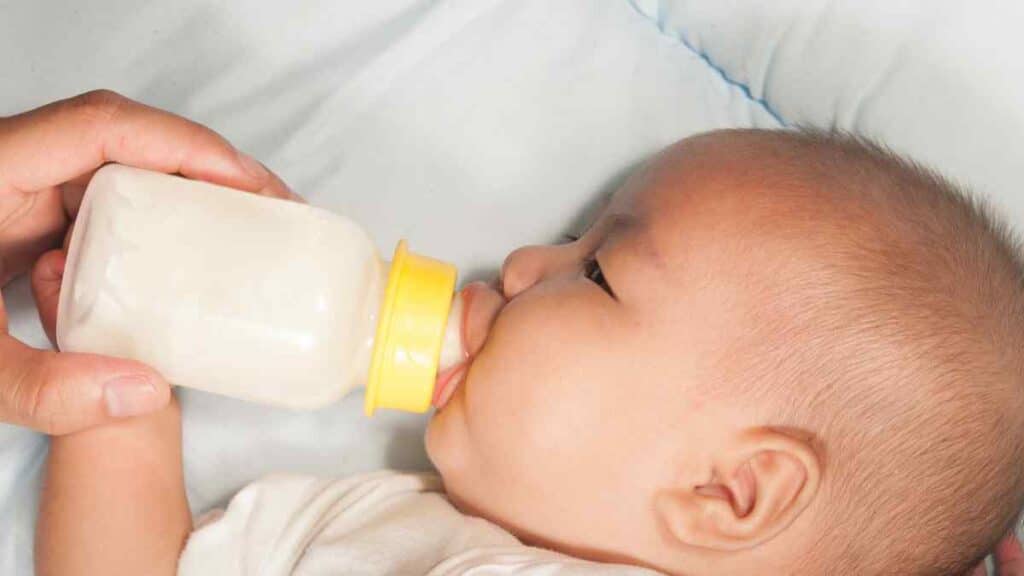
As the wheels of your journey touch down and you gather your belongings, there’s a profound sense of accomplishment that comes with successfully navigating the skies with your little one. In this comprehensive guide, we’ve embarked on a journey of our own, exploring the intricacies of traveling with baby formula on a plane. From meticulous planning to in-flight feeding strategies, we’ve covered every step of the way to ensure a seamless and stress-free experience.
Through research and preparation, you’ve become well-versed in the nuances of airline policies, destination regulations, and the art of packing baby formula. Armed with knowledge, you’ve confidently chosen the right formula type and harnessed the power of well-packaged, labeled, and documented supplies.
Remember, each flight is a unique chapter in your family’s story, and as you write those chapters, you’re crafting memories and imparting invaluable lessons of resilience and adaptability. You’ve shown that with preparation, patience, and a touch of flexibility, you can soar to new heights with your baby by your side.
Did this article help? Please let us know in the comments. If you have any questions, don’t hesitate to ask.
Read more articles
Jul 4, 2024
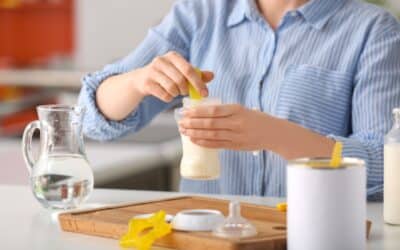
FDA Issues Warning About Baby Formula Contaminated with Cronobacter Bacteria
The US Food and Drug Administration (FDA) has warned that baby formula may be contaminated with Cronobacter bacteria....
Jul 3, 2024
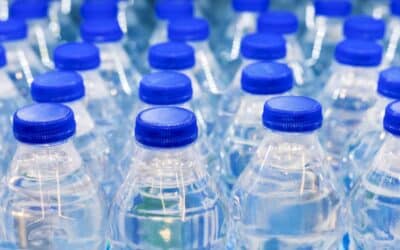
Fiji Water Recall: Baby Water Remains Safe, Here’s the Truth
Fiji Water recently announced a recall affecting a specific batch of its products due to safety concerns. The news has...
Jul 2, 2024

The Impact of Water Quality on Baby’s Skin Health
The impact of water quality on the health of our environment and personal well-being receives much attention. Still,...
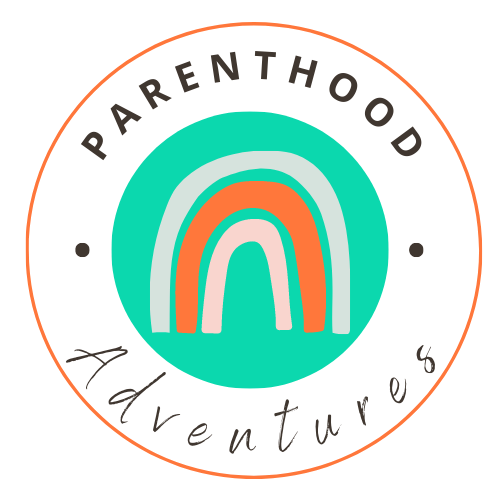
- Baby and Toddler Travel Tips
- Diaper Bags and Suitcases
- Best Travel Strollers and Tips
- Packing Lists + Hacks
- Baby travel must haves
- Babywearing
- Destinations
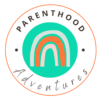
- Trip Planning
How to Travel with Baby Formula on a Plane
By the time my son turns two, we will have taken him on over 100 flights from shorter jaunts to nearby states to international flights that lasted for 16+ hours. Over that time we’ve gone from combo feeding him to transitioning to 100% formula.
Thankfully it’s pretty simple to bring your baby’s food along once you know the rules and best practices. Here’s everything to know about how to successfully travel with baby formula when you fly:
TSA Regulations for Carry-Ons
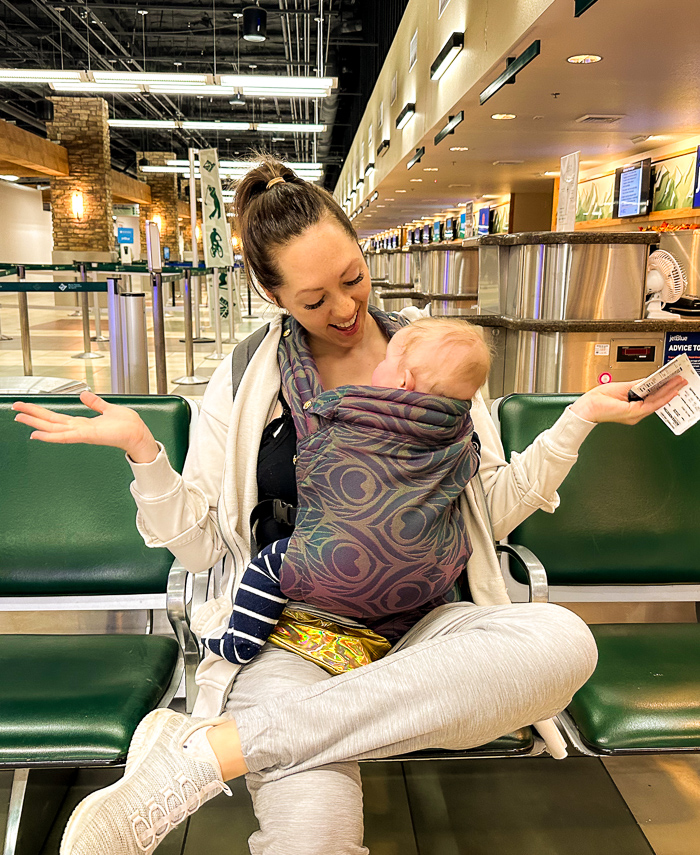
The first important thing to know is the TSA regulations regarding liquids, as you will most certainly have extra checks. Be sure to budget extra time for this! Whether you have TSA precheck or not, the following considerations all apply:
Liquid amounts
For baby food including breast milk, water for formula, liquid formula, juice, and other forms of milk, you’re allowed to bring “a reasonable amount” of each above the 100ml/container limit.
The amount that is reasonable to take through security is left up to the TSA officer. I have actually run into issues with this when they wanted us to dump one of our water bottles for his formula when our flight was only about an hour and a half. For reference we had 240 mls. I knew we were within our rights to have all of the water, and in case we had delays in the air, which has happened to us before, we needed to have it along. I remained polite but firm that we were allowed to have it and asked to speak to a supervisor, who agreed that the amount we had was, indeed, reasonable. If we’d had to dump, we could have bought water in the terminal, but I preferred to use our own.
I highly recommend printing out or saving TSA rules to your phone in case you run into any issues. Read full TSA rules here.
Extra checks
Almost no TSA experience has been the same for me, but 80% of them have involved extra checks for the liquids. Be sure to let the officer know before you go through security that you have liquids in excess of 100ml/3oz for your baby. They will probably pull them out for extra screening.
They are allowed to put the bottles through an extra machine and they are allowed to unscrew the top for a vapor test, they are not allowed to stick anything into the liquid.
I highly recommend using clear bottles , which usually means easier screening and fewer vapor tests.
Powder checks
If you have powder formula, they will probably run a white test strip over it for bomb testing as well. I have never had them open up the formula, but rather run the strip on the outside of the container. As far as I know there is no limit on the powder amounts. I’ve brought entirely full cans with me many times.
If you’re traveling abroad, be sure to look into the rules for the specific country you’re traveling out of. So far going through customs in Mexico and Japan , the experience has involved no additional checks and was much easier than US security.
Packing Formula Safely and Effectively
The worst thing would be a formula spill en route when it’s difficult to impossible to replace the formula. I’ve never actually seen formula for sale in the airport, and as far as I know Emirates is the only airline that stocks it onboard, so make sure that you bring more than enough with you in case of delays, and pack it securely.
We sometimes transfer formula to a clean Tupperware with locking lids. I also will store a can with a secure lid in the diaper bag. I make sure that I only bring unopened bags and cans of formula in my checked baggage and wrap them in clothing so that they don’t get jostled and burst. Though we don’t use liquid formula, I’d do the same with liquid cans.
That said, weight from liquid can add up quickly, and they tend to take up a lot more space, so if you also use powder, I would recommend only traveling with the powder. Also be sure to check whether your destination has formula you can easily buy. If you use a hypoallergenic or speciality formula, you may need to bring it all with you. We could have easily bought more in Mexico and Japan, though I’ve heard in destinations like Thailand it can be harder to find.
If You Need to Warm the Water
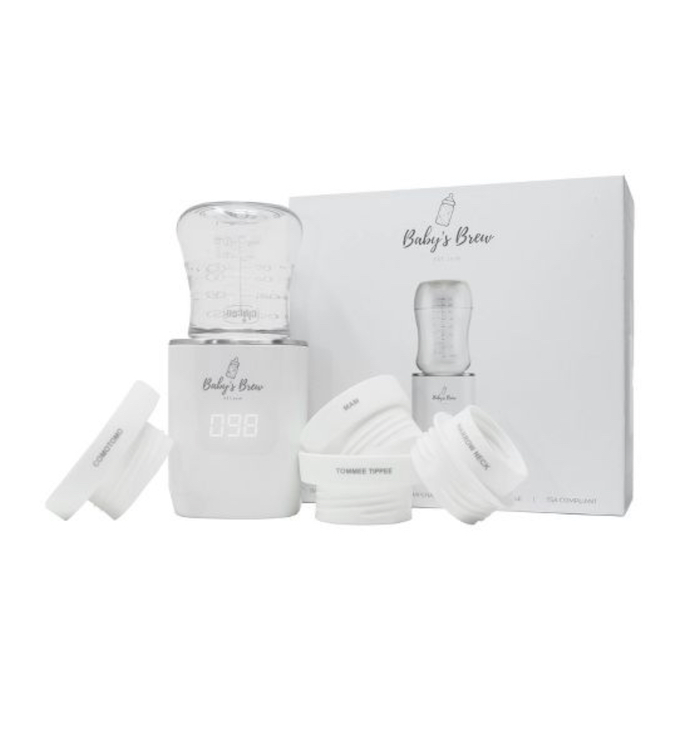
The best thing we ever did is slowly start only serving our baby room temperature formula. According to the CDC , formula does not need to be warmed to be safe to drink. When he’s hungry, we can just make a bottle on the spot. I like to pre-fill his Comotomo bottles with the exact amount of oz we’ll need for ease.
But what if your baby prefers it warm? No problem, this portable bottle/formula warmer can be charged ahead of time (or in your seat in a pinch). Consider bringing a portable power bank to recharge the warmer as needed.
I have also been offered warm water from flight attendants previously, but since we only use bottled or boiled filtered water for his formula, I’ve used what we brought since I know the origins of it.
Washing Bottles on the Go
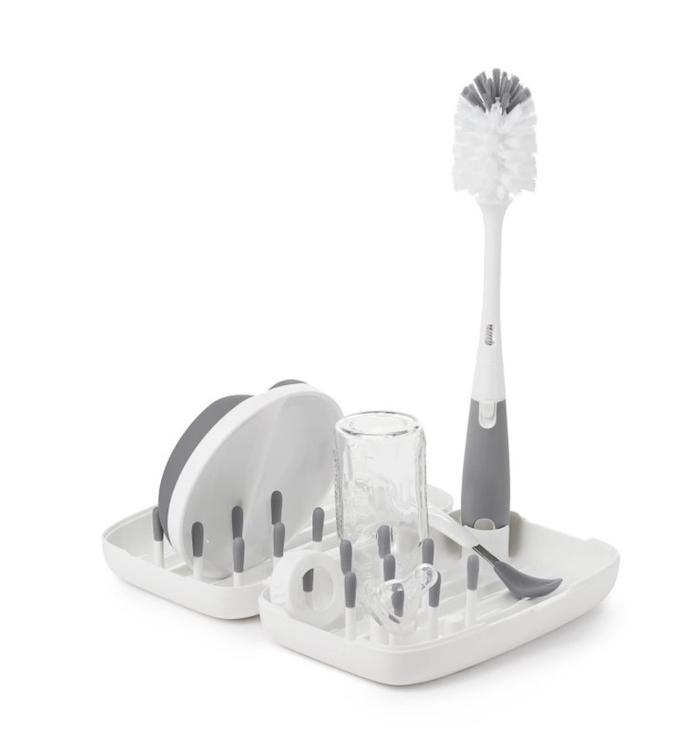
I’m in love with our OXO baby bottle brush and drying rack . I joke it’s the best $18 I’ve ever spent. We even use it at home to keep our son’s bottles totally separate from the rest of our dishes.
It folds up for easy portability and fits into our diaper bag with ease. I recommend bringing your own soap in a carry-on size bottle since airport and airplane soap is usually not the kind that you would want to use on bottles. It can be heavily scented, foam, or high in chemicals and antibacterial agents.
You can easily wash bottles in the airport bathroom or lounges. On the flights, I use filtered water from my own water bottle that I get in the terminal. If I’m out of that, I asked the flight attendant for a bottle of water. It’s never been an issue. I tend not to use the water from the top on planes as sometimes it’s not potable and I also I’m not sure about the state of their water trucks. For me I would not care, but for my baby I’m extra cautious.
Where, When, and How to Feed
As formula feeding parents know, the ease of being able to bottle feed anywhere is delightful. We have walked through the airport with our son in a carrier ( I like this one for travel days) feeding him while we walk. We are also always sure to feed during takeoff and landing to help clear his ears.
Formula feeding has been way easier than pumping, though if you combo feed, I have tips for pumping on the go and traveling with breast milk for you, too.
Overall, flying with formula is pretty simple once you know the rules and how to properly store it. It’s a bit more to travel with, but it’s not a big deal, either. Happy flying!
*Some links in this post are affiliate links that support us at no extra cost to you when you purchase through them. We only recommend products we love and use ourselves. Your trust always comes first!
Kristin is the founder of Parenthood Adventures, combining her love of travel and newfound joy of motherhood. She's the creator of one of the most-read women's travel blogs in the world, bemytravelmuse.com, with a readership in the millions each year.
Similar Posts
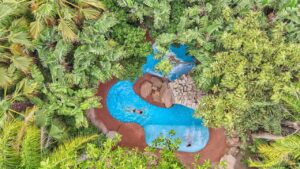
7 of the Best Italy Resorts for Kids
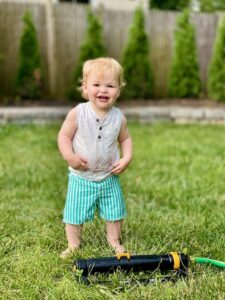
105 Fun Free Things to Do with Kids
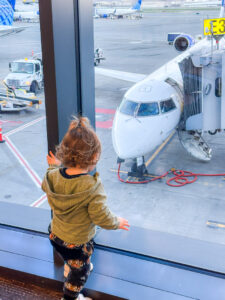
At What Age Can Children Fly For Free?
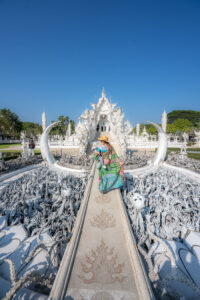
Thailand with a Baby or Toddler – The Ultimate Guide

International Travel with a 6-Month Old Baby Tips and Tricks

What is a Family Restroom and Who is it For? (And NOT for?)
Taking our first flight with our daughter (3 months old) next week. It’s a 12 day trip which is a bit intimidating! I am combo feeding so this is helpful! Planning to leave my pump supplies at home and just do breast/formula.
You got this! Have fun! It’s a great age to travel with.
Leave a Reply Cancel reply
Your email address will not be published. Required fields are marked *
Save my name, email, and website in this browser for the next time I comment.
This site uses Akismet to reduce spam. Learn how your comment data is processed .
Upcoming Event : CPR and Choking Skills Class Saturday, March 23rd - 9:00am, Little Chicken, 35 First Ave., Atlantic Highlands
- East Coast Baby Co.
- Dec 22, 2023
Traveling with Baby Formula on an Airplane: A Helpful Guide
Traveling with a baby can be challenging, especially when it comes to handling their feeding needs. Fortunately, the Transportation Security Administration (TSA ) has specific guidelines to make flying with baby formula, breast milk, and baby food easier and stress-free. Here's a comprehensive guide for parents and guardians to navigate these rules with ease.
Understanding TSA Guidelines for Baby Formula and Breast Milk
1. Carrying Larger Quantities: The TSA allows formula, breast milk, toddler drinks, and baby/toddler food, including puree pouches, in quantities greater than 3.4 ounces (100 milliliters) in carry-on baggage. These items do not need to fit within a quart-sized bag and are considered medically necessary liquids.
2. Screening Process: Inform the TSA officer at the beginning of the screening process that you are carrying these items. Remove them from your carry-on bag to be screened separately from your other belongings. TSA officers may test the liquids for explosives or concealed prohibited items.
3. Packaging Recommendations: While not mandatory, using clear, translucent bottles for formula and breast milk can expedite the screening process. Liquids in plastic bags or pouches may require additional screening steps.
4. X-ray Screening: TSA X-ray machines are safe for food and medicines. If you prefer not to have these items X-rayed or opened, notify the TSA officer for alternative screening methods.
Special Considerations for Cooling Accessories
Ice packs, freezer packs, frozen gel packs, and other cooling accessories are permitted in carry-ons. If these items are partially frozen or slushy, they will undergo the same screening as liquids.
Liquid-filled teethers are also allowed. Side note: For breastmilk storage, the Ceres Chill is our favorite!
Tips for a Smoother Journey
Prepare Ahead: Pack your baby's feeding supplies in an easily accessible part of your carry-on for quick removal during screening. Communicate Clearly: Always inform TSA officers about the presence of baby formula and related items to avoid misunderstandings. Opt for Transparency: Use clear bottles if possible, to reduce the need for additional screening.
Know Your Rights:
If you are carrying breast milk or formula, and your child or infant is not traveling with you, you are still allowed to bring these items.
Traveling with baby formula on an airplane doesn't have to be a daunting experience. By following TSA guidelines and preparing ahead, you can ensure a smoother and less stressful journey for both you and your little one. Remember, these rules are in place to ensure the safety of all travelers while accommodating the needs of parents and guardians with infants and toddlers.
Happy travels!
Recent Posts
Business Spotlight: Meet Dr. Kyle Klim, Owner of Pleasantly Pregnant
Breast Pumping Tips for New Moms Returning to Work
Business Spotlight: Meet Cristina Frank, Owner of Flow to Grow Wellness

East Coast Baby Co. proudly serves NJ, NY, PA, CT, RI, & DE. Live outside of this area? Send us a message. We would love to work with you!
© 2023 East Coast Baby Co.
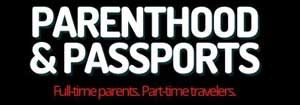
Flying with Breastmilk, Formula, and Baby Food: An Easy How-To Guide
- Post author By Melissa
- No Comments on Flying with Breastmilk, Formula, and Baby Food: An Easy How-To Guide

Any family traveling with a baby will inevitably face the challenge of transporting breastmilk or formula during a trip. Even if you exclusively breastfeed, a stash of milk, whether expressed breastmilk or formula, is one of the most essential travel items for babies .
Traveling, particularly by plane, can be very dehydrating. And you don’t want to be empty handed or helpless if you experience an unexpected dip in your supply or your baby needs to nurse more than usual.
This is why it’s important to always travel with breastmilk or emergency formula during the baby stage. While the idea of flying with breastmilk may seem daunting, it really isn’t complicated.
However, there are a few things to know about flying with breastmilk, liquid formula, or baby food that will make the process easier.
This guide covers the United States TSA guidelines regarding transporting pumped milk and includes personal tips and advice for flying with breastmilk, flying with formula, or taking baby food through airport security.
Our experience flying with breastmilk
Our daughter was exclusively breastfed until she was about nine months old. We began traveling with her shortly after she was born. So, on more than one occasion, we had to fly with breast milk.
We even flew internationally a couple of times during those first months and brought expressed milk along for the journey. In fact, when our daughter was 6 months old, we flew to Costa Rica for her first international trip.
I was still breastfeeding almost exclusively but didn’t want to have an infant attached to my body the entire trip. So, we decided to travel with breastmilk that was previously pumped.
This was our first experience flying with breastmilk. We didn’t quite know what to expect, but luckily, our family and the breastmilk made it there safely.
In that first year of our daughter’s life, we flew numerous times. We have successfully brought breast milk through airport security and have also flown with liquid formula, juice, and baby food without any issues.
What you need to know about flying with breastmilk or liquid formula
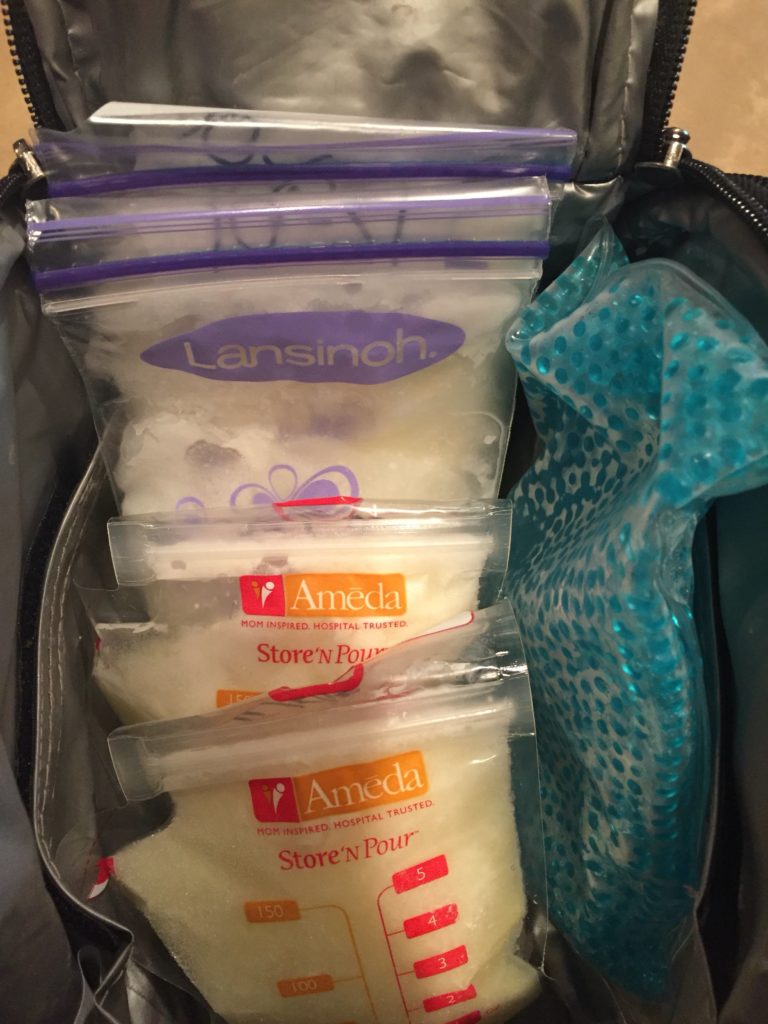
Although most things are more challenging when flying with a baby, airlines and airport security agents are more lenient when it comes to the tiniest of travelers.
Here are a few things to know about flying with breastmilk or other baby liquids.
TSA liquid limits don’t apply to breastmilk
Although the TSA has a very small limit on the amount of liquids you can bring on a plane. The 3.2-ounce rule does not apply to breastmilk, liquid formula, or baby food.
You can actually bring large quantities of these liquids through airport security. Or as the TSA ambiguously puts it “ reasonable quantities ” of breastmilk are allowed in your carry-on bag.
With that said, we have personally brought about a dozen bags of breastmilk, some frozen and some fresh breast milk, through airport security without any problems.
Frozen gel packs are also allowed
Aside from bags of breastmilk or containers of liquid formula, you can also bring gel freezer packs through TSA to keep your liquids cool or frozen. Keep in mind, even in an insulated bag or cooler, ice packs do not stay frozen for more than a few hours.
If you plan to fly with frozen milk, be aware once it thaws completely you must use it within 24 hours. So, I would not recommend bringing too many bags of frozen breast milk on a long flight.
Consider giving your baby milk from your frozen stash in the days leading up to your trip. Pump when you would typically feed your little one to have a supply of fresh milk ready for your trip.
Breast pumps are typically allowed in addition to your carry-on and personal item
It is important to note that you can also bring a breast pump through TSA or airport security if you plan to pump while on your trip or vacation.
Breast pumps are considered a medical device. So, most airlines will not count them as part of the carry-on and personal item allowance. Be sure to check with your airline before your flight.
However, most will allow mothers to bring a breast pump in addition to their carry-on and personal item. Many breast pumps are somewhat bulky, which can make them challenging to travel with. However, there are some great travel breast pumps that are compact and easy to clean when on a trip.
You do not need to be traveling with your baby to fly with breastmilk
If you are a mother traveling solo and are still nursing, you will likely have to pump while on your trip to avoid discomfort and keep your milk supply up.
No mom wants to dispose of pumped breastmilk. (There is a reason they call it liquid gold!) But luckily, you don’t have to, at least if flying domestically within the United States.
The Transportation Security Administration allows you to fly with a reasonable quality of breastmilk, whether your baby is with you or not. However, that rule does not apply to flying with liquid formula .
Although, I don’t know why you would need to fly with formula if your baby is not with you.
Taking breastmilk or liquid formula through airport security

If you plan to travel with breastmilk or liquid formula that needs to be kept cool, keep it in its own small bag rather than placing it in your carry-on luggage.
You are allowed to bring a separate bag for breast milk storage or formula in addition to your carry-on bag and personal item.
Keeping the liquids separate makes it easier for screening purposes. This is the bag I use and I demonstrated above how I pack it when flying with breastmilk. It is an insulated bag that serves as the perfect breast milk cooler, so the milk stays frozen or cold longer.
Let the TSA agent know your traveling with breastmilk or formula
When you arrive at the security checkpoint, tell the TSA agent you are flying with breastmilk or formula. Then, put the bag on the conveyor belt for inspection. It will need to be sent through the X-ray machine.
Don’t worry, the X-ray machine does not harm the breastmilk .
If you do not want it to go through the X-ray machine, you will need to inform the agent. You can opt-out of X-raying the milk. In that case, however, your milk or formula will likely be opened and have to go through additional screening.
Security agents will test some of your milk
TSA will inspect, and even open your breastmilk to run tests on it. The process doesn’t take long and doesn’t taint the milk.
If traveling with powdered formula instead of liquid, you can also bring bottled water through security. You just need to specify that the water is for the baby.
Allow extra time
Always when traveling with a baby or toddler, you should allow yourself extra time at the airport.
The additional screening of your milk will take some extra time, although not much, but you may also have extra gear, like a travel stroller that needs to be broken down, or a framed child carrier for a toddler , that will have to be removed and sent through the X-Ray machine.
However, if you plan to wear your baby in a baby carrier while traveling , most of them do not have to be removed to go through security screenings. In fact, babywearing at the airport is one of the best ways to save time and make flying with a baby easier.
Shipping breastmilk
Shipping breastmilk is an alternative to flying with breastmilk, and luckily there are companies that specialize in this. There are several options to easily and effectively ship breast milk.
Here are some convenient ways to ship breastmilk if you prefer to do so rather than fly with breastmilk.
- Milk Stork is a company dedicated exclusively to shipping breast milk. They send containers that you can fill and ship overnight.
- FedEx also has a milk shipping program, where they can overnight breastmilk in refrigerated containers. Similar to Milk Stork, you can pre-ordered milk bags to fill up. Then, just drop them off at a FedEx location for overnight delivery.
What you need to know about flying with baby food

Traveling with baby food falls under the same category as traveling with breastmilk or formula, with a few exceptions.
You are allowed to bring enough for the duration of your trip. If you are gone for a week, that is quite a bit of baby food pouches or jars.
I recommend the baby food pouches when traveling with a baby and especially when traveling with a toddler . They are much easier to use on-the-go, and many older babies and toddlers can even feed themselves.
Like breastmilk and formula, you will have to separate baby food from the rest of your carry-on luggage and declare it with the TSA officer.
They will likely inspect it and possibly open one of the containers. If that happens, plan to use that one first since once opened baby food should be used within a day.
Giving Your Baby a Bottle of Breastmilk or Formula on the Plane

If you prefer to give your baby a bottle instead of breastfeeding on a plane , you can request a cup of hot water from the flight attendant upon boarding. Put a bag of cold (not frozen) breast milk in the cup for a few minutes to warm it up, if your baby will not drink it cold.
The water can also be used to mix dry formula if needed.
Nursing or bottle-feeding during takeoff and landing will help avoid any ear discomfort for your little one caused by the pressure change when ascending or descending.
Flying internationally with breastmilk, formula or baby food

While we have never personally had a problem flying internationally with breastmilk or baby food, it is important to note that other countries may not be as lenient.
Each country may have its own rules and restrictions that apply. Be sure to check with your airline or the international airport from which you will be flying prior to your trip.
Although we have never had an issue, we have read stories of moms having to dump out breastmilk before their flight.
Final thoughts on flying with breastmilk, formula or baby food

Whether you breastfeed, exclusively pump, formula feed or choose a combination of those methods, flying with breastmilk, formula, or even baby food and juice doesn’t have to be difficult. When you travel with breastmilk, baby food, or formula, plan to pack enough for an extra day or so.
Traveling can be unpredictable, flights can get cancelled, you may have an unanticipated long layover , and your trip may end up being longer than expected. So be prepared, and pack accordingly.
For this reason, we do not recommend traveling with breast milk in your checked luggage.
Do you have a question or comment about how to travel with breastmilk, formula, or baby food? We’d love to help. Leave us your thoughts in the comments below.
Like it? Pin these tips on flying with breastmilk to save for later!
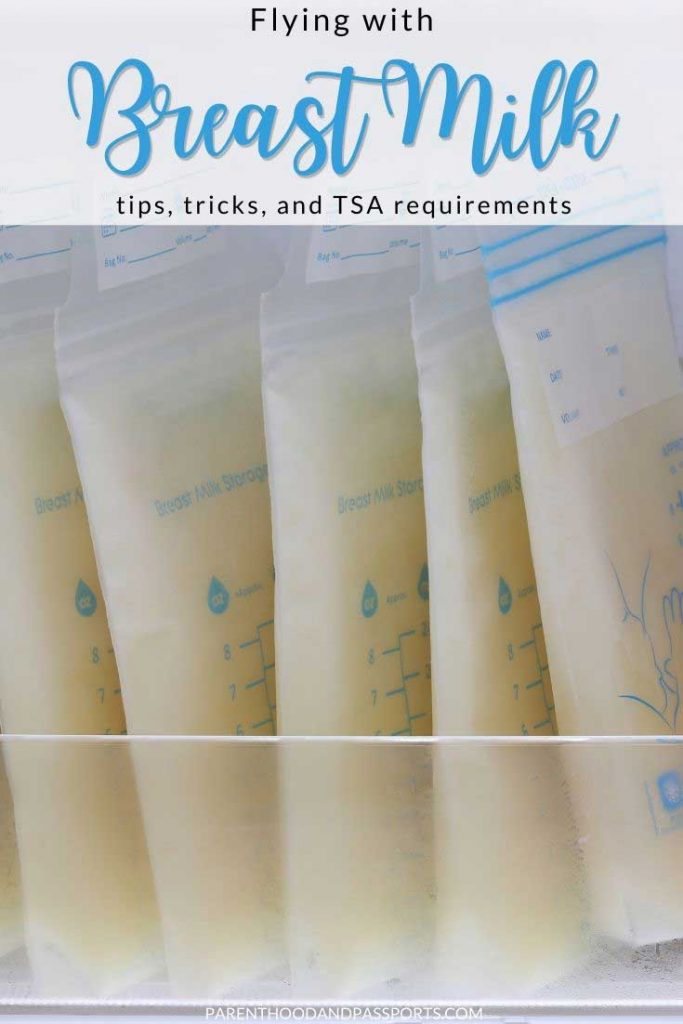
Did you know…
When you make a purchase or book hotels, tours, or other travel services, through our links, we receive a small commission, at no extra cost to you. We only EVER recommend service providers, websites, or products we personally use when booking our own travels. Your support enables us to keep producing helpful travel content. Thank you!
- Book a HOTEL
- Book a RENTAL CAR
- Purchase TRAVEL INSURANCE
- Book guided tours or excursions at GET YOUR GUIDE or VIATOR
- Book a DESTINATION PHOTOGRAPHER
- Buy TRAVEL GEAR on Amazon
- Buy a PRIORITY PASS MEMBERSHIP for airport lounge access
Sharing is caring!
Related Posts:

Leave a Reply Cancel reply
Your email address will not be published. Required fields are marked *
Sign me up for the newsletter!
This site uses Akismet to reduce spam. Learn how your comment data is processed .

TSA Baby Food & Formulae Rules (Plus Tips for Flying)
THIS POST MAY CONTAIN COMPENSATED LINKS. FIND MORE INFO IN MY DISCLAIMER.
Home » TSA Baby Food & Formulae Rules (Plus Tips for Flying)
It’s finally time for your baby’s first trip on an airplane. Luggage is packed , the itinerary is planned, and the camera is ready to snap a million first-time family travel photos.
But what about food for the flight?
While traveling with a baby , one of the biggest concerns for us parents is making sure that our little ones are well-fed and comfortable. Especially if the flight is going to be a long one.
A full tummy keeps your munchkin happy and playful, which is the best-case scenario while you’re up in the air.
TSA Baby Food & Formulae Rules (Plus Tips for Flying)
The TSA is pretty strict about what you can and what you cannot carry on the plane. Especially liquids.
But baby foods are an exception. If you follow their rules and guidelines properly, there should be no hassle in carrying your baby food and baby formula past the security and onto the flight.
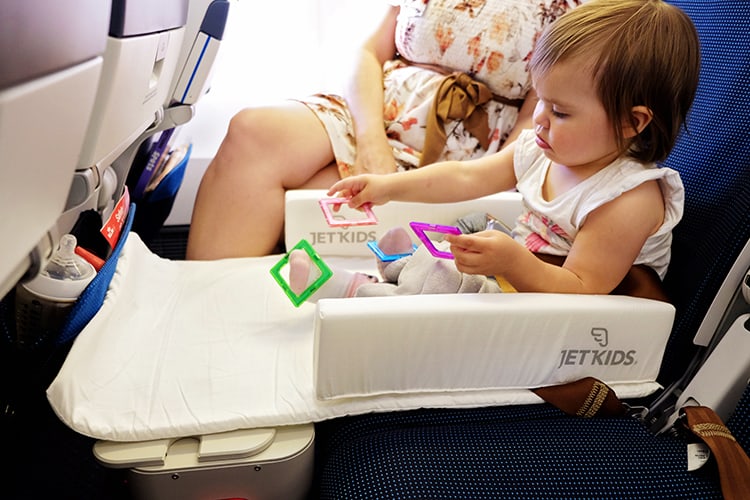
Can You Bring Baby Food on an Airplane?
Anyone traveling with an infant is allowed to pack baby food, milk, and juice for the flight into a carry-on.
While the TSA has strict rules about other liquids and foods allowed on the plane, baby food and formulae are less restricted. You may bring as much baby food as you need.
Tip: Check out what we like to use for packing baby food for the airplane.
TSA Rules for Baby Food
The TSA aims to protect passengers while traveling. Which is why they are so particular about the items in your carry-on bags.
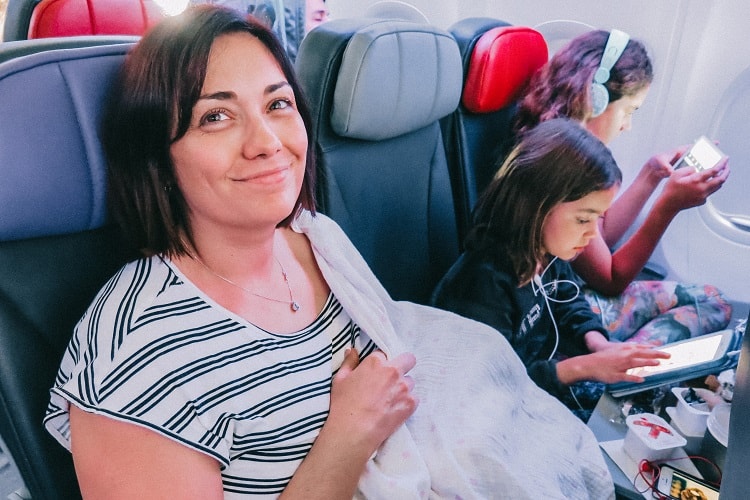
They have a list of food and liquids that are allowed on the plane, as well as how much.
However, not all of the rules apply to baby food and liquids, regulations are quite simple for infants:
- You must be traveling with the baby to carry food (obviously)
- Keep your baby food and other liquid carry-on items separate
- Inform the TSA officer that you are carrying these liquid food items at the checkpoint
Traveling with Formula and Baby Food
It’s always a good idea to know in advance what you’ll be required to do at the airport in terms of security procedures while traveling with formula and baby food.
1. Notify the TSA When Traveling with an Infant
Just as you need to remove your laptops from your carry-on bag during the screening process at the airport, the same is required of baby food as well.
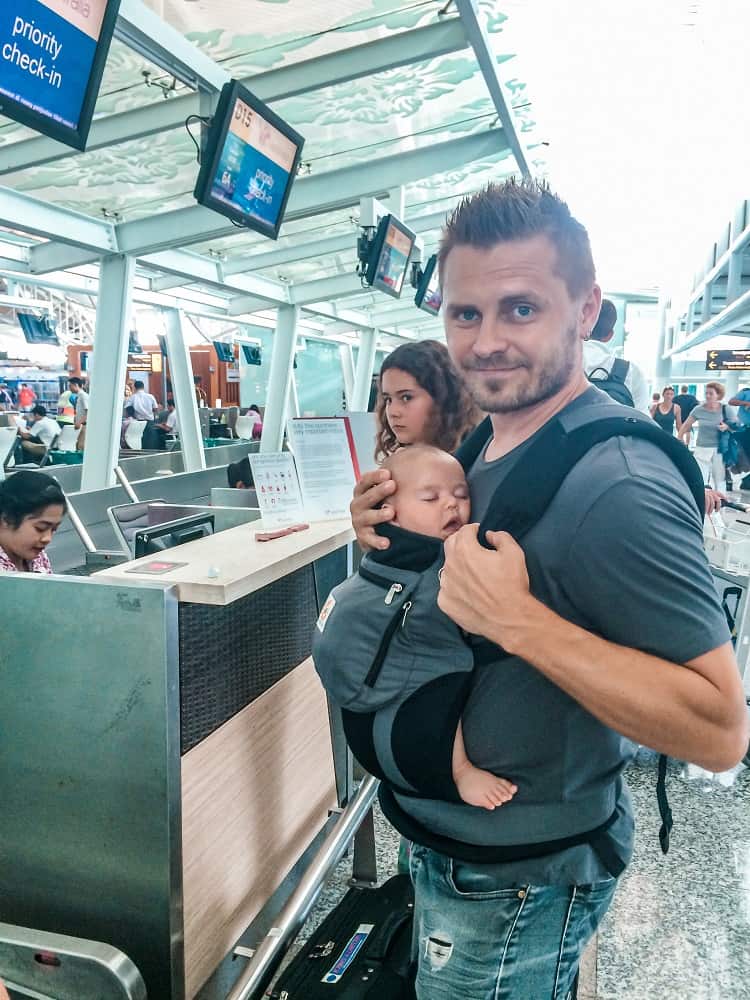
At the security checkpoint, take your formula, juices, breast milk, and other baby foods that may be in liquid form out of your bags. They will be screened separately.
You will have to inform the TSA officer before the screening that you’re traveling with a toddler and are carrying liquid baby foods in excess of the permitted limit.
2. Liquid Rule Exemption for Baby Food on Planes
Typically, the permitted quantity of liquids that you can carry on a plane is 3.4 ounces(100 milliliters).
But when it comes to baby food, this is often not nearly enough for a full flight.
Thankfully, the TSA understands this and allows you to travel with as much as you need.
In addition, if you need to carry additional paraphernalia such as ice and frozen gel packs to keep your baby food fresh, you’re allowed to do so.
But they are subject to the same screening process as the rest of your baby food items.
3. Screening Process for Baby Food and Baby Formulae
The TSA officers need to be absolutely sure that the liquids that you’re carrying are safe for the other passengers on the flight.
Hence, they are screened thoroughly for concealed prohibited items.
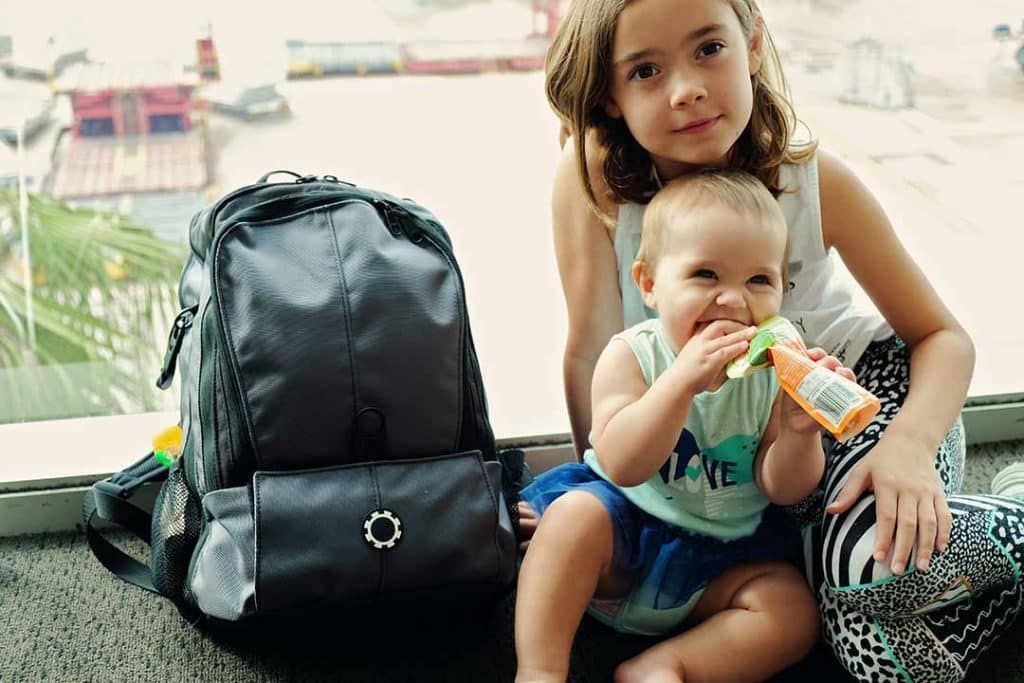
You might even be asked to open the bottle and dispose of it a little bit or transfer it to another empty container, which is also screened.
If you’re specific about the fact that the bottle must not be opened before consumption, you can inform the TSA officer and they will find an alternate method of screening.
You may then have to undergo a more vigorous check yourself before they clear you to carry your baby formula on the plane.
4. TSA PreCheck with Kids
When you’re traveling with baby formula, it’s always better to get TSA PreCheck . You can also get a free TSA precheck .
This will help you get a Trusted Traveler Number, which means that you qualify for expedited screening.
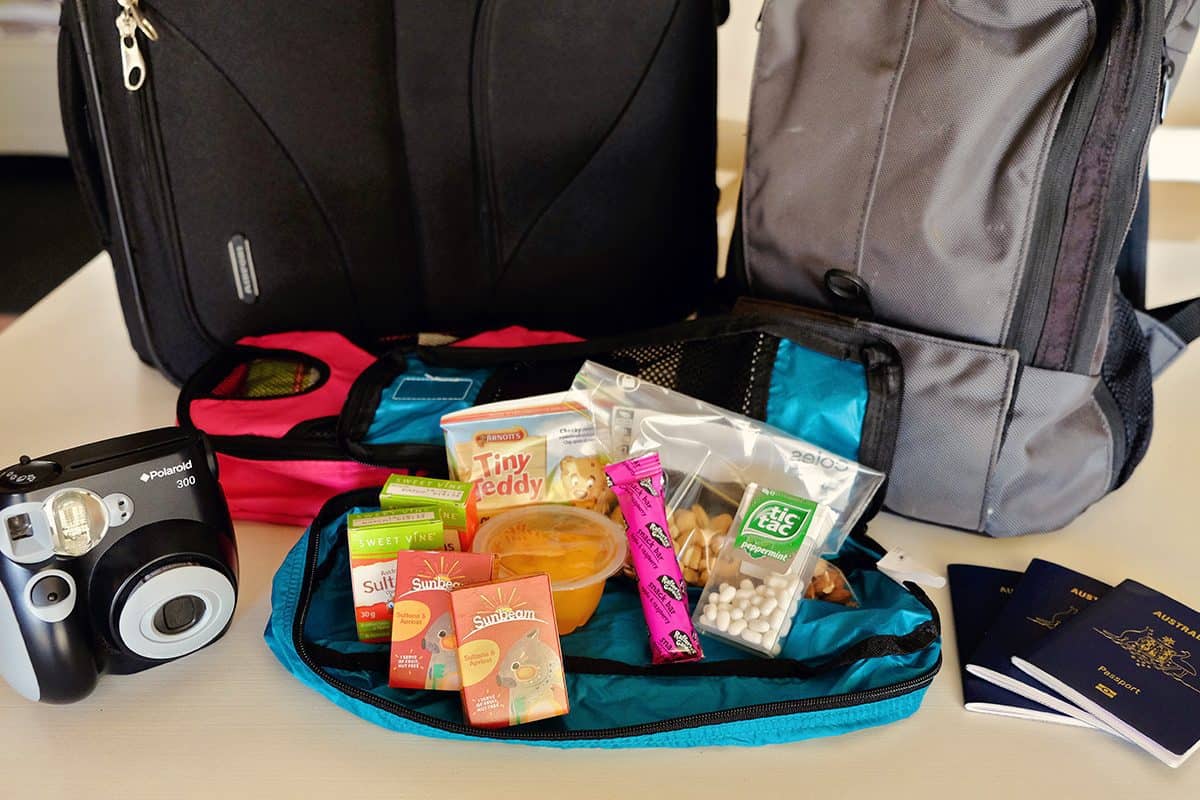
TSA PreCheck queues are much shorter relatively and you have to spend very little time awaiting your turn.
In addition, you don’t need to take off your shoes, and your laptops can stay put in your carry-on bags .
But the biggest advantage for people flying with baby food pouches and breast milk is that they do not need to take these contents out of their bags.
Sure, the bags are screened from the outside for detecting explosives, but that’s about it.
Your formula can stay arranged in the bag and doesn’t need to be taken out until it’s time to feed your baby.
Having said that, you may still be asked to remove the baby food pouches and bottles from your bag under certain circumstances.
Read more about the TSA PreCheck Process here.
5. Carrying Water to Make Baby Food on the Airplane
Since you’re traveling with baby food, you’re definitely going to need water to make fresh formula when your little peanut gets hungry.
It’s advisable to buy bottled water after the check-in point from an authorized vendor, instead of bringing it from home.
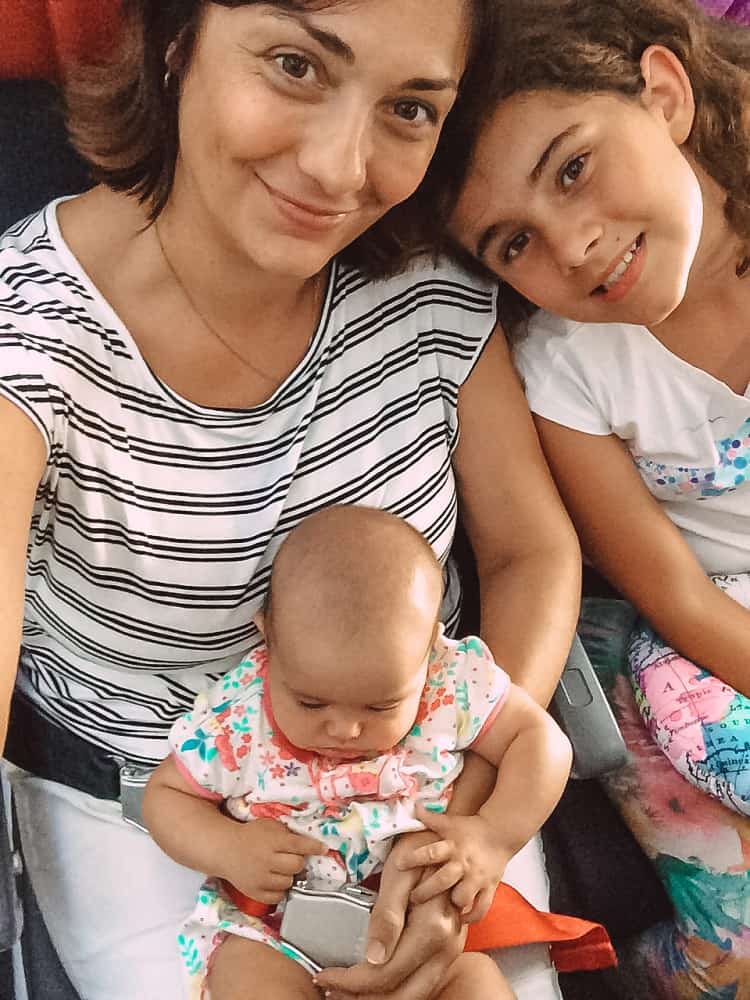
While the TSA does not restrict carrying food items for your little ones, they may want you to discard the water, as it’s easily available beyond the check-in point.
You can carry an empty thermos along with you which can easily be filled at the many water fountains at the airport.
Another alternative would be to ask your flight attendant for a sealed water bottle before mixing up your formula.
Avoid using tap water from the bathroom faucets of the airplane as it’s not considered safe for your child’s sensitive tummy.
6. Pre-Preparation when Flying with Baby Formulae
It’s essential to be prepared for your baby’s hunger needs on the airplane. Preparing a bottle in a small space, with a baby on your lap or playing next to you isn’t ideal.
You may have no choice, for an emergency feed, but try to have as many of your feeds already planned for and portioned into bottles.
That way, you will only have to pour water into them later, eliminating the need to deal with loose powder.
This will also save you the hassle of additional screening by the TSA as your baby food will not be in liquid form at the time of check-in.
Tip: You might be also interested in reading our article about tips for surviving the trip with your little one here .
How to pack formula for air travel?
Getting past the TSA is one thing, but you also need to make your life easier by packing the formula for maximum convenience.
1. Carry a Formula Dispenser with Sections
If your formula dispenser is sectioned, you won’t have to worry about measuring the powder quantity every time you make the formula on the plane.
Each section of the dispenser can simply be emptied into a bottle to make enough for a single feed.

Check out the price for this formula dispenser on Amazon here .
2. Take a Cooler Bag when Traveling with Baby Food
In addition to carrying ice and gel packs, it’s important to carry your baby food in a cooler bag as it helps keep your breast milk and other pouches fresh for a longer duration.

Check the price for this baby food cooler bag on Amazon now .
3. Carry Extra Formula
As we mentioned, the restrictions on baby food are much lighter than usual TSA regulations.
So pack a little extra and be prepared in the case of delays.
Summary – Flying with Baby Food
Traveling with kids requires a little more preparation and planning, but it’s often easier than it seems at first.
With a few tips and tricks up your sleeve, you can make some of the best memories of your life traveling with your little ones.
The TSA is meant for the safety of the people and they are extremely cooperative when you’re traveling with children.
There’s no limit on the amount of food you can carry for your little ones.
Tip: Check our article on what accessories to take for a long haul flight here .
Not sure where to go for your first vacation? Here is our list of the best places to travel with a 1 year old .

Andrzej Ejmont
2024 - Wanderlust Storytellers. All Rights Reserved.
About Us | Contact Us | Work with Us | Privacy Policy | Disclaimer
* Disclaimer: Wanderluststorytellers.com is a participant in the Amazon Services LLC Associates Program, an affiliate advertising program designed to provide a means for sites to earn advertising fees by advertising and linking to amazon.com and other Amazon sites.
- Flying With a Toddler Tips
- Packing List
- Best Toddler Travel Accessories
- Family Travel Tips

TSA Guidelines for Baby Formula Transportation
Traveling with a baby can be a stressful experience, especially when it comes to navigating through airport security. The Transportation Security Administration (TSA) has strict guidelines in place for carrying liquids, including baby formula, through security checkpoints. It is important to understand these guidelines and be prepared before arriving at the airport to ensure a smooth and stress-free experience.
Understanding TSA Guidelines for Baby Formula is crucial for parents traveling with infants and toddlers. According to TSA regulations, passengers are allowed to bring a reasonable amount of baby formula, breast milk, or juice for their child through the security checkpoint. These items are exempt from the 3.4-ounce liquid limit, but they must be declared to the TSA officer for inspection. It is recommended to pack these items separately from the rest of your carry-on luggage to make the screening process easier.
Key Takeaways
- Understanding TSA Guidelines for Baby Formula is crucial for parents traveling with infants and toddlers.
- Preparation is key for a smooth TSA experience when traveling with baby formula.
- Special considerations and tips can help make the process easier and less stressful.

Understanding TSA Guidelines for Baby Formula
Traveling with a baby can be stressful, especially when it comes to packing all the necessary items. One essential item is baby formula. It is important to understand the TSA guidelines for baby formula to ensure a smooth and hassle-free travel experience.
TSA Regulations on Baby Formula and Breast Milk
The TSA regulations allow passengers to bring baby formula, breast milk, and juice for infants or toddlers in reasonable quantities through the security checkpoint. These items are exempted from the 3.4-ounce liquid rule. However, they must be presented for inspection at the security checkpoint.
Passengers traveling with baby formula or breast milk should inform the TSA officer at the beginning of the screening process. The formula or milk will be subject to additional screening, which may include opening the container and transferring a small amount of the liquid to a separate empty container for testing.
Preparation for Airport Security
When traveling with a baby, it is important to be prepared for airport security to ensure a smooth and stress-free experience. Here are some tips on how to prepare for airport security when traveling with baby formula and accessories.
Packing Baby Formula and Accessories
When packing baby formula and accessories, it is important to keep in mind the TSA regulations. Baby formula, breast milk, and juice are allowed in reasonable quantities in carry-on bags. However, they must be declared for inspection at the security checkpoint.
It is recommended to pack baby formula and accessories in a separate bag or container to make it easier for TSA officers to inspect. This can also help prevent spills and leaks in your other belongings.
Carry-On Baggage Rules for Baby Essentials
When traveling with a baby, it is important to know the carry-on baggage rules for baby essentials. Each passenger is allowed one carry-on bag and one personal item, such as a diaper bag, for free.
Baby essentials, such as diapers, wipes, and baby food, are allowed in carry-on bags and do not count towards the liquid limit. However, they must be removed from the carry-on bag and declared for inspection at the security checkpoint.
It is also important to note that all liquids, including baby formula, breast milk, and juice, must be placed in a quart-sized bag and presented for inspection at the security checkpoint.
By following these tips, parents can ensure a stress-free experience when traveling with baby formula and accessories.
At the Security Checkpoint
When traveling with a baby, parents and caregivers need to be aware of the TSA regulations regarding baby formula and breast milk. Here are some important things to know about the security screening process at the checkpoint.
Screening Process for Baby Formula and Breast Milk
Baby formula and breast milk are allowed in reasonable quantities in carry-on bags. These items are not subject to the usual liquid restrictions, but they must be screened separately from the rest of the carry-on items.
Parents and caregivers should inform the TSA officer at the checkpoint that they are carrying baby formula or breast milk. They should also remove these items from their carry-on bags and place them in a separate bin for screening.

Additional Screening Procedures
In some cases, the TSA officer may need to perform additional screening procedures on baby formula or breast milk. This may include opening the container and testing the contents for explosives or other harmful substances.
Parents and caregivers should be aware that the additional screening procedures may take some extra time. They should plan accordingly and arrive at the airport early to allow for any delays.
Interacting with TSA Officers
Parents and caregivers should remain calm and polite when interacting with TSA officers at the checkpoint. They should follow all instructions and be prepared to answer any questions about the baby formula or breast milk they are carrying.
If a parent or caregiver has any concerns or questions about the security screening process, they should ask the TSA officer for assistance. The TSA officer is there to help ensure the safety of all passengers and will do their best to answer any questions or concerns.
Overall, parents and caregivers should be aware of the security screening process for baby formula and breast milk when traveling with a baby. By following the TSA regulations and remaining calm and polite when interacting with TSA officers, parents and caregivers can help ensure a smooth and stress-free travel experience.
Special Considerations for Baby Formula
When traveling with a baby, it’s important to consider the special needs of their formula. Here are some guidelines to follow when traveling with baby formula.
Handling Frozen Items and Cooling Accessories
When traveling with frozen items such as ice packs, freezer packs, or gel packs, it’s important to make sure they are completely frozen before packing them in your carry-on bag. TSA allows frozen gel packs as long as they are frozen solid when presented for screening. If the gel pack is partially melted, slushy, or has any liquid at the bottom of the container, it will not be allowed through security.
Formula cooling accessories are also allowed through security. These include insulated bags, bottle coolers, and other items designed to keep formula cool. However, they must be removed from your carry-on bag and placed in a bin for screening.


Guidelines for Liquid, Powdered, and Puree Formulas
When it comes to baby formula, there are three main types: liquid, powdered, and puree. Each type has its own guidelines for traveling with it.
Liquid formula is allowed in carry-on bags in quantities greater than 3.4 ounces, but it must be declared at the security checkpoint. TSA may need to perform additional screening on the formula, so allow extra time for this process.
Powdered formula is also allowed in carry-on bags, but it may be subject to additional screening. TSA may need to open the container and test the powder for explosives. To avoid delays, pack powdered formula in a separate container and declare it at the security checkpoint.
Puree pouches are allowed in carry-on bags, but they must be screened separately from other liquids and gels. Pack them in a clear plastic bag and remove them from your carry-on bag for screening.
By following these guidelines, parents can ensure that their baby’s formula is safe and secure during air travel.
Traveling with Infants and Toddlers
Traveling with infants and toddlers can be a daunting task, especially when it comes to bringing along feeding accessories and additional items. However, with a little preparation and knowledge of TSA regulations, parents and guardians can make the process much smoother.
Feeding Accessories and Additional Items
When traveling with an infant or toddler, it is important to pack enough formula, baby food, and toddler drinks to last the duration of the trip. TSA allows these items to be brought through security in reasonable quantities, but they may need to be screened separately from other carry-on items. It is recommended to pack these items in a clear plastic bag and inform the TSA officer at the checkpoint that you are traveling with these items.
Breast milk pumping equipment is also allowed through security, but it must be removed from its carrying case and screened separately. It is recommended to bring only the necessary equipment and to pack it in a separate bag to make the screening process easier.
Accommodations for Parents and Guardians
TSA Cares is a program designed to assist travelers with disabilities and medical conditions, including those traveling with infants and toddlers. Parents and guardians can contact TSA Cares to request assistance with navigating the security screening process and to receive information on what to expect at the checkpoint.
In addition, many airports offer accommodations for parents and guardians traveling with infants and toddlers, such as designated family restrooms and nursing rooms. It is recommended to research the airport beforehand to find out what accommodations are available.
Overall, traveling with infants and toddlers can be a manageable experience with the right preparation and knowledge of TSA regulations. By packing feeding accessories and additional items properly and utilizing accommodations available, parents and guardians can make the trip much smoother for themselves and their little ones.

Prohibited Items and Security Measures
Understanding prohibited items.
The Transportation Security Administration (TSA) has strict rules regarding what items are allowed in carry-on bags and checked luggage. It is important for travelers to understand these rules to avoid delays and confiscation of items. Prohibited items include explosives, firearms, and certain types of liquids.
Baby formula is allowed in carry-on bags, but it is subject to additional screening. Liquid-filled teethers and plastic bags containing formula are also allowed, but they must be removed from the bag and screened separately. It is recommended that travelers bring only what is needed for the duration of the flight to avoid delays.
Advanced Screening Technologies
The TSA uses advanced imaging technology (AIT) to screen passengers and their belongings. AIT uses non-ionizing electromagnetic waves to create a detailed image of the individual and their belongings. This technology is safe for all passengers, including pregnant women and children.
Passengers who are selected for additional screening will be asked to step into the AIT machine and raise their arms. The machine will scan their body and create an image that will be reviewed by a TSA officer. If any prohibited items are detected, the passenger will be subject to further screening.
In addition to AIT, the TSA also uses other advanced screening technologies to detect prohibited items. These technologies include liquid explosives detection systems and explosive trace detection machines.
Overall, it is important for travelers to understand the TSA’s rules regarding prohibited items and security measures. By following these rules and being prepared for additional screening, travelers can help ensure a safe and efficient travel experience.
Tips for a Smooth TSA Experience
Traveling with a baby can be a daunting experience, especially when it comes to passing through TSA security checkpoints. However, with a few simple tips and tricks, parents can ensure a smooth and stress-free TSA experience.
Efficient Packing and Formula Preparation
Efficient packing is key when traveling with a baby. It is important to pack baby formula, bottles, and any necessary feeding accessories in an easily accessible location in your carry-on bag. This will allow for quick and easy access during the TSA screening process.
When it comes to formula preparation, TSA regulations state that formula, breast milk, and juice for infants or toddlers are allowed in reasonable quantities through the security checkpoint. It is important to note that formula must be presented for inspection and that all containers must be sealed and labeled with the baby’s name.
To save time and ensure a smooth TSA experience, parents can prepare baby formula in advance. TSA regulations allow for pre-mixed liquid formula in quantities of 3.4 ounces or less, as well as powdered formula in any quantity. Parents can also bring an empty bottle or thermos to fill with water for formula preparation once they have passed through security.
Utilizing TSA Resources and Support
TSA offers a number of resources and support for parents traveling with infants. Parents can request a private screening area for themselves and their baby or toddler, as well as a pat-down instead of going through the metal detector or full-body scanner.
TSA also offers a helpline, TSA Cares, which provides travelers with disabilities and medical conditions, including those traveling with infants, with assistance and information about the security screening process. Travelers can call the helpline at least 72 hours prior to their flight for assistance and to ask any questions they may have.
In conclusion, efficient packing and formula preparation, as well as utilizing TSA resources and support, can help parents ensure a smooth and stress-free TSA experience when traveling with a baby. By following these simple tips, parents can focus on enjoying their travels with their little one.
Frequently Asked Questions
How should baby formula be packed for air travel.
When traveling with baby formula, it is important to pack it properly to ensure that it is easily accessible and does not spill or leak during the flight. The formula should be packed in a clear, plastic, quart-sized bag and placed in a carry-on bag. It is recommended to pack enough formula for the entire trip, plus a little extra in case of delays or unexpected events.
Is it permissible to bring powdered baby formula on an airplane?
Yes, powdered baby formula is allowed on airplanes. It is important to note that the formula should be in its original packaging and the container should be sealed. If the container has been opened, it must be inspected by the TSA officer at the security checkpoint.
What are the TSA guidelines for traveling with baby formula?
The TSA has specific guidelines for traveling with baby formula. Parents or guardians are allowed to bring a reasonable amount of formula through the security checkpoint, even if it exceeds the 3.4-ounce liquid limit. The formula will be subject to additional screening, including X-ray and other types of inspection.
Can I carry hot water for baby formula through airport security?
Yes, parents or guardians are allowed to bring hot water for baby formula through airport security. The water must be in a thermos or other insulated container and will be subject to additional screening. It is important to note that the water must be tested by the TSA officer to ensure that it does not exceed the 3.4-ounce liquid limit.
What identification is required for a child when flying with the TSA?
Children under the age of 18 are not required to provide identification when traveling with the TSA. However, it is recommended to bring a copy of the child’s birth certificate or passport as a precaution.
Are there any restrictions on the amount of baby formula you can take on a plane?
There are no specific restrictions on the amount of baby formula that can be taken on a plane. However, it is important to pack enough formula for the entire trip, plus a little extra in case of delays or unexpected events. The formula will be subject to additional screening, including X-ray and other types of inspection.

Popular Posts

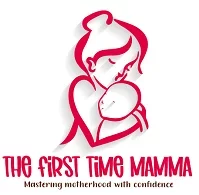
How to travel with a ready to feed formula
Going on a journey with a baby is a feat you don’t hear from most parents. It doesn’t matter if it is a short journey – like going out to the park or beach – in the afternoon or a long journey across or out of the country; you need to be prepared at any time to feed your baby when they are hungry. Babies typically get hungry every 2 – 4 hours.
Hey! By the way… any links on this page that lead to products on Amazon are affiliate links and I earn a commission if you make a purchase. Thanks in advance – I really appreciate it! .
It is easier to feed a baby if you are breastfeeding compared to when they are bottle-fed. All you need is your breast and probably a nursing shawl – voila! You are all set.
But when you are traveling with a bottle , either for breast milk or formula; you need to be aware of so many rules, especially when flying! You will also need a well-stocked cooler bag to store the leftover formula properly.
What is ready to feed formula?
Ready to feed formulas are infant formulas that do not need pre-measurement or mixing before feeding your baby. They typically come in fluids, 2, 6, or 8-ounce containers.
Although more expensive than other formulas, using this formula is convenient and easy to use for your baby during travels. It is sterile, rich in nutrients, and you don’t need to mix it with water before feeding it to your little one.
You can store unopened Ready to feed formulas at room temperature. But ensure to keep opened containers for reuse in a refrigerator for about 48hours.
While you are on a journey, you may feed your baby this formula at room temperature, or you could warm the milk.
With different bottle warmers available in the market, you can get one to warm the milk while on a trip. You could also put the bottle into a container with hot water from a flask to warm up your baby’s food.
Traveling with a ready to feed formula
When traveling with your bottle-fed baby, ready to feed formula is undoubtedly the most convenient option to select. Besides being slightly costlier than the other baby formula options, you don’t need to use boiled water to make the baby food, nor do you need sterile water for it. Additionally, it is convenient and doesn’t make a mess.
When Travelling by Air
Most parents ask “Can I take ready to feed formula on a plane? Yes, you can take ready-made baby milk on the plane. The fluid guidelines seem to be continually changing. The TSA termed formula and breastmilk as “medically necessary liquid and gels,” and fortunately, they allow liquids exceeding 3.4 ounces or 100ml when you are traveling with an infant. You may need cooling packs or other cooling accessories to preserve the baby food while on a journey.
The baby formula and cooling packs are screened separately, just as with other liquids while traveling by air. To hasten your check-in process, you should perhaps put all your baby formulas and cooler bags in your carry-on . At the start of the screening, you should inform the TSA officer that you are carrying more than 3.4 ounces of premixed baby food.
You are permitted to take as much infant formula as you need to the plane to make baby feeds during your journey. Also, you can go with as many bottles or cartons of ready-made milk in your hand luggage. Although, security officers at the airport may request you open the bottles and taste the contents.
Can you bring powdered formula on a plane?
Yes, you can bring powdered formula on a plane. The Transportation Security Administration (TSA) specified that parents can take a reasonable amount of powered milk in a plane.
Can you bring premade formula on a plane?
Yes, you can bring premade formula on a plane for your baby.
How much-powdered formula can you take on a plane?
TSA specified that parents can carry up to 3.4-ounces of liquid for babies. However, if you need to take more than 3.4 ounces for your baby, inform a TSA agent before the day you want to travel.
Does premade formula need to be refrigerated?
Yes, you need to put them in bottles and refrigerate them once you have mixed the powdered formula with water.
What Do You Need To Do To Prepare Your Baby’s Formula?
Before making your infant’s bottle:
- Make sure you thoroughly read the instructions.
- Ensure that you buy the correct formula to match your little one’s age.
- Don’t feed infants toddlers’ formula because they have different nutritional requirements.
Once you get this right, you can prepare your baby’s formula.
Check the Instructions to prepare the Ready to Feed Formula.
Infant formulas all look alike. So, before preparing your baby’s bottle, ensure that you read the label and instructions. The Ready-Made Formula does not require additional water mixed in. They are already premixed. Adding water will dilute the nutrients in the baby’s food, and your baby might become malnourished.
To avoid such, go through and follow the manufacturer’s instructions before you feed your baby the formula.
You will need the following supplies to make your baby’s bottle:
- Clean Baby Bottles and Nipples: Ensure that you take more than you need on the journey because you may not have the chance to clean the bottles while on the trip.
Alternatively, you can use disposable bottle liners . They are great when you can’t access sterilizing equipment. They ensure less cleaning time, and you pack fewer bottles.
- The Premixed Formula: This could be in a can or bottle. Be sure to pack more than enough as you don’t want to risk not being able to get when you reach your destination as a sudden change in the formula could make your little one cranky.
- Opener for the canned formula: You will need an opener to puncture a hole into a ready-made canned formula .
- Burp Cloth – could be a muslin cloth or bib: This is necessary for when you burp your baby, or they drool or spit out their food while feeding. The burp cloth will keep you and your baby clean.
- You need Sterilizing Material: To prevent contamination of your baby’s equipment, sterilizing wipes and Ziploc bags to separate clean and dirty bottles, nipples, etc.
- Bottlebrush : Use the bottlebrush to clean the baby’s bottle after feeding.
- Cooler Bag: The cooler bag is is necessary to keep the bottles cold after you have opened them. You can also use ice packs, freezer packs , frozen gel packs, etc., required to preserve the opened formula.
How To Prepare The Premixed Formula
Firstly, you should wash your hands properly just like you would when making any food.
Then unscrew the formula bottle or make a hole on top of the canned formula. If you are using a previously opened bottle or can, it should be open for less than 48hours; otherwise, dispose of it.
Next, measure the exact amount of formula your baby needs for feeding into the bottle. You may warm the bottle by carefully dipping it into a container of warm water.
Lastly, ensure that you store the leftover formula properly in the cooler bag. Do not keep a premixed formula for more than 48hours.
How to go out with ready to feed formula?
Thinking of going out with your baby and the ready to feed formula? You need to know that once you open the ready to feed formula, you have to use it for the baby within an hour. If not, you can keep it in a cooler with ice. This will make it last for 48 hours.
Can you take unopened formula on a plane?
Instead of using the unopened formula on the plane, you can get the baby formula travel dispenser to make life easy for you and the baby. It easily fits in the diaper bag and it has enough room for your baby’s formula. The makes it easy to take ready formula on the go.
Can you take pre-made formula through airport security?
Yes, you can. According to the Transportation Security Administration (TSA) , you can carry formula in reasonable quantities in carry-on bags.
Traveling with ready to feed formula is very convenient and makes feeding your baby hassle-free while you are on a journey. This article helps you prepare the necessary materials for a comfortable trip for you and your baby.
About The Author
Hephzy Asaolu
Minima + Regula
Minima + Maxima
Luggage Set
ENTER FOR A CHANCE TO WIN A 4-NIGHT STAY IN CANCUN!
Tsa rules for traveling with baby formula.
If you’re traveling with an infant, then bringing baby formula with you is essential. It can be confusing to figure out what the TSA’s rules are when it comes to bringing baby formula on a plane. This guide will provide an overview of the TSA’s rules for traveling with baby formula, so you can be prepared and have a stress-free trip.
Table of Contents
TSA Rules For Flying With Baby Formula
Traveling with a baby can be stressful, especially when it comes to navigating airport security with their essentials like baby formula. However, the Transportation Security Administration (TSA) has rules in place to make sure that baby formula is allowed on board planes without any issues.
Frequent Travel Recommendations
Hey there! ✈️ I'm thrilled to share some fantastic travel recommendations with you! I receive numerous emails asking for the best travel advice, and after careful consideration, here are my top picks just for you. Get ready to explore incredible destinations and enjoy some amazing deals that have been curated based on popular demand. So, without further ado, here are the travel experiences I highly recommend. Let the adventures begin! 🌍🌟
Travel Insurance
SafetyWing — For general travelers and digital nomads with great rates.
Viator — The largest selection for almost all locations.
Expedia Flights — Large selection for flights.
Expedia Hotels — Large selection for hotels.
Booking.com — The largest selection for hotels.
Click on the links above to get the best deals!
Thanks for the support! - Tiffany
Firstly, the TSA allows travelers to bring an unlimited amount of baby formula or breast milk through security. It does not have to be stored in a clear, plastic bag like other liquids, but it must be declared to the TSA officer during the screening process. Additionally, travelers are allowed to bring ice packs, freezer packs, and gel packs to keep their baby formula cold. However, if these items are not completely frozen or solid when going through security, they may be subject to additional screening or even confiscation.

When it comes to bringing baby formula on the plane, it can be brought in either carry-on baggage or checked baggage. If bringing it in carry-on baggage, it is recommended to place it in a clear plastic bag for easy inspection by the TSA officer. If bringing it in checked baggage, it is still important to pack it properly and securely to prevent any leakage or damage. It may be a good idea to pack it in a separate bag within the checked baggage for extra protection.
In summary, the TSA rules for flying with baby formula are that it can be brought through security without any limitations, it can be brought in carry-on or checked baggage, and ice packs or freezer packs can also be brought to keep the formula cold. By following these rules and properly packing the baby formula, traveling with a little one can be much less stressful.
TSA Rules For Flying With Breast Milk
If you’re traveling with breast milk, there are specific TSA rules you’ll need to follow to ensure that you can bring it with you on the plane. Here are some key guidelines to keep in mind:
- Breast milk is exempt from the TSA’s liquids restrictions. This means you can bring as much breast milk as you need, as long as it’s for your baby.
- Breast milk must be in a container that holds no more than 5.4 ounces (or 160 milliliters).
- Breast milk can be in either a bottle, storage bag or packing cube .
- You must inform TSA officers that you have breast milk in your carry-on luggage before going through security.
- You may be asked to undergo additional screening procedures to verify the contents of your breast milk.
- If you’re traveling with a breast pump, you may bring it as a carry-on or checked baggage.
It’s also worth noting that some airlines have their own policies regarding traveling with breast milk. For example, some airlines may allow you to bring an ice pack to keep your breast milk chilled during the flight. Others may require you to inform them in advance that you’ll be traveling with breast milk. As always, it’s a good idea to double-check with your airline and the TSA before you travel to ensure that you have all the information you need to make your trip as smooth as possible.
Rules For Flights In The USA
When it comes to traveling with baby formula in the USA, the TSA has specific guidelines that must be followed. First and foremost, you are allowed to bring baby formula in your carry-on bag in quantities greater than 3.4 ounces. This includes ready-to-feed formula, powdered formula, and liquid concentrate formula.
It is important to note that you may be required to undergo additional screening at the security checkpoint. This could include a thorough inspection of your baby formula, so it is best to keep it in its original packaging and make it easily accessible. If you prefer to bring your baby formula in your checked baggage, you can do so as well. Just make sure it is packed securely and labeled clearly. It is also recommended to bring a copy of the manufacturer’s instructions in case TSA needs to inspect it. While the TSA does allow for the transportation of baby formula, it is important to remember that the 3-1-1 rule still applies to other liquids, such as water and juice. Any liquids that are not related to your baby’s needs will need to adhere to the standard TSA guidelines.
In summary, traveling with baby formula in the USA is allowed, but it is important to follow TSA guidelines and be prepared for potential additional screening. Whether you choose to bring it in your carry-on or checked baggage, ensure it is packed securely and labeled clearly to avoid any confusion.
Rules For Flights In Other Countries
If you’re planning on traveling internationally with your baby and need to bring formula, you’ll need to be aware of the rules for flights in other countries. In general, most countries follow similar rules as those in the US, but there may be slight variations to be aware of. Firstly, it’s always a good idea to check the airline’s specific policies for bringing baby formula onboard. Some airlines may have additional requirements or restrictions, so it’s best to double check before your flight.
When traveling to another country, you should also research their specific customs and border protection agency’s rules for bringing in baby formula and other liquids such as honey . For example, some countries may have restrictions on the amount of baby formula that can be brought in or require a doctor’s note or import permit.
In addition, if you plan to transfer flights or have a layover in another country, you’ll also need to be aware of their rules for bringing baby formula onboard. It’s possible that you may need to adhere to the stricter of the rules between the countries you are traveling to and through. As always, it’s recommended that you bring only what you’ll need for the duration of your trip to minimize any potential issues at customs or security checkpoints. And remember to properly label and store your baby formula and any other baby food or snacks to ensure their safety during your travels. By understanding the rules for flights in other countries, you can be well-prepared for a stress-free journey with your little one.
Bringing Baby Formula In Your Carry-On
If you’re flying with a baby , it’s important to pack their baby formula carefully to ensure it’s allowed on the plane. Luckily, TSA has specific rules for traveling with baby formula, and as long as you follow these guidelines, you shouldn’t have any problems getting through security.
When it comes to carrying baby formula in your carry-on, there are a few rules you need to be aware of. First and foremost, any baby formula or food that is liquid, gel, or aerosol must be placed in containers that are 3.4 ounces or less and stored in a clear, quart-sized plastic bag. This bag should be placed in an easily accessible location in your carry-on so that it can be quickly and easily removed at security. It’s important to note that this 3.4-ounce limit is per container, so if you’re carrying a larger bottle of formula, it will need to be divided into smaller containers. This may be a bit of a hassle, but it’s necessary to comply with TSA regulations.
Another thing to keep in mind is that you may be asked to open the containers of baby formula or food during the security screening process. This is to ensure that the contents are indeed baby formula and not a prohibited item. If you’re uncomfortable with opening the containers, you can request that a TSA officer use a swab to test the contents instead.
Finally, if you’re traveling with pre-mixed liquid baby formula, you can bring as much as you need for the flight in your carry-on. However, if you’re traveling internationally, you may be subject to different rules depending on the country you’re visiting, so be sure to check ahead of time. Overall, as long as you follow the rules outlined by TSA, you shouldn’t have any problems bringing baby formula in your carry-on. Just make sure to pack it carefully and have it easily accessible for security screening.
Bringing Baby Formula In Checked Baggage
If you are traveling with a larger amount of baby formula, you may choose to bring it in your checked baggage. In general, the same rules apply for checked bags as they do for carry-on bags. You can pack as much formula as you need in your checked baggage, but it is important to make sure that it is properly stored and secured to prevent spills and leaks. Consider placing the formula in a plastic bag or container to avoid any messes in your suitcase.
It is also recommended to pack the formula in your checked baggage if you will not need it during your flight. This way, you will have more space in your carry-on for other essentials. Remember that some countries may have restrictions on bringing certain liquids or powders into the country, so be sure to check with your airline or the destination country’s regulations before packing baby formula in your checked baggage.
Overall, bringing baby formula in your checked baggage can be a convenient option for parents traveling with a larger supply. Just make sure to pack it carefully and follow any applicable regulations to ensure a smooth and stress-free travel experience.
Do I Have To Take Out Baby Formula At Security?
Yes, you do. According to TSA regulations, all liquids, including baby formula and your baby car seat , should be taken out of your carry-on bags and screened separately. This means that you need to take your baby formula out of your carry-on and place it in a separate bin for screening. TSA officers may ask you to open the container and test the formula for security reasons. To make the screening process smoother, you can keep your baby formula in an easily accessible spot in your carry-on bag. TSA recommends packing your formula in a clear plastic bag to keep it organized and make the screening process easier.

Note that you don’t have to take out your baby formula from checked baggage. You can keep it in its original packaging or a clear plastic bag and pack it in your checked luggage. It’s also worth noting that TSA may allow a reasonable amount of formula, breast milk, or juice in excess of 3.4 ounces in your carry-on if you’re traveling with a baby or a young child. However, you may need to declare these items at the security checkpoint for inspection. To avoid any delays or issues at security, it’s always a good idea to check the TSA guidelines before your trip and pack your baby formula accordingly.
What Other Baby Foods Are Allowed On Plane?
Aside from baby formula, there are other types of baby food that are allowed on planes. These include:
- Breast Milk : If you are breastfeeding, you are allowed to bring breast milk on a plane. You do not have to worry about the liquid restrictions that apply to other types of liquids, but you may be required to declare it to TSA officers at the security checkpoint.
- Baby Food In Jars Or Pouches : You are allowed to bring jars or pouches of baby food on a plane. These are considered to be liquid, so they must be packed in your checked luggage if they exceed the 3.4-ounce limit.
- Snacks For Toddlers : If your child is eating solid food, you can bring snacks like crackers, cheese, fruit, and veggies on the plane.
- Teething Biscuits : Teething biscuits are also allowed on a plane, but be aware that they can crumble and make a mess.
It’s important to note that TSA may inspect your baby food items to ensure that they are safe for travel. Be prepared to have your items inspected and be patient with TSA officers during the process.
Can You Use Your Baby Formula On A Plane?
Yes, you can use your baby formula on a plane. However, it is important to keep in mind that once the plane has taken off, you may not have access to hot water to warm the formula. Additionally, if you are traveling with pre-mixed formula, it is best to bring enough for the duration of the flight since flight attendants may not be able to provide additional formula during the flight. It is also important to ensure that the formula is stored properly and remains within a safe temperature range.
If you are traveling with a baby under two years old, many airlines, such as American Airlines , will allow you to bring a car seat on board the plane. This can be helpful for keeping your baby safe and comfortable during the flight, as well as for securely holding the bottle while your baby feeds. Alternatively, you may choose to hold your baby and feed them the bottle directly. Overall, using baby formula on a plane is allowed and common. Just be sure to plan ahead and take necessary precautions to keep your baby safe and comfortable during the flight.
Can I Breast Feed On A Plane?
Yes, you can breastfeed on a plane. The TSA permits breastfeeding on board, and most airlines also allow mothers to breastfeed their babies during the flight. You don’t have to cover up, but you may want to use a nursing cover for privacy if you prefer. However, if you are concerned about the potential for turbulence, you may want to consider breastfeeding before takeoff or after landing. Additionally, if you need assistance finding a comfortable spot to breastfeed, don’t hesitate to ask a flight attendant for help. They are usually happy to assist mothers in finding a comfortable spot. Remember, you have the right to breastfeed your baby in public, and the same applies when you are traveling by air.
How Much Baby Formula Can You Take On A Plane?
One of the most common questions asked by parents traveling with young children is how much baby formula they are allowed to bring on a plane. The answer depends on a few factors, including the length of your flight, your destination, and the policies of the airline you’re flying with. In general, TSA regulations allow you to bring a reasonable amount of baby formula or breast milk on board a flight. This means that you are allowed to bring enough for the duration of your journey, plus a little extra just in case of delays.
For domestic flights within the USA, there are no specific limits on how much baby formula you can bring, but it must be in containers of no more than 3.4 ounces (100 ml) each, and it must be placed in a clear plastic bag for security screening. You are allowed to bring multiple containers as long as they fit in the bag and don’t exceed the volume limit.
For international flights, the rules can vary depending on your destination. Some countries may have restrictions on the amount of baby formula and medical marijuana you can bring, or require a doctor’s note if you’re carrying a large quantity. It’s important to check with your airline and the embassy or consulate of your destination country before you travel to make sure you’re following all the necessary rules. If you’re traveling with a baby, you can also bring pre-mixed formula in ready-to-feed bottles on board the plane, although they can take up more space in your carry-on luggage. Powdered formula is also allowed, but it’s important to note that you may be asked to open the container and have it tested by security.
Finally, it’s important to keep your baby formula and baby food safe and cool during your journey. You can bring a small insulated bag or cooler to store your baby’s food, and ask for ice from the flight attendants if needed. In summary, the amount of baby formula you can bring on a plane depends on your destination and airline, but in general, you’re allowed to bring enough for the duration of your flight plus a little extra. Make sure to follow the TSA rules for carry-on liquids and keep your baby’s food safe and cool during the journey.
Can You Bring Baby Formula Powder On A Plane?
Yes, you can bring baby formula powder on a plane, but it may be subject to additional security screening . Powdered formula is not considered a liquid, so it is exempt from the 3-1-1 rule, which limits the amount of liquids you can bring in your carry-on bag. However, because powdered formula looks similar to other powders, it may be subject to additional screening by TSA agents. This may involve a swab test or a manual inspection of the powder container. To avoid any delays at the security checkpoint, it’s a good idea to pack the formula powder in its original packaging, with the ingredients list visible, and to label it as baby formula.
It’s also worth noting that some airlines have restrictions on the size of containers for baby formula powder. For example, Delta Air Lines allows containers up to 12 ounces in carry-on bags, while American Airlines allows up to 18 ounces. Be sure to check with your airline before packing your formula powder to ensure compliance with their policies. Overall, it is possible to bring baby formula powder on a plane, but it’s important to follow the rules and guidelines set forth by the TSA and your airline to ensure a smooth and hassle-free travel experience.
How To Keep Baby Formula And Baby Food Safe On Board?
Once you have made sure that your baby formula is allowed on board, it is important to ensure that it stays safe during the flight. Here are some tips on how to do that:
- Pack It Correctly : Whether you are bringing baby formula in your carry-on or checked baggage, it is important to pack it properly as you would your baby stroller . Keep the formula in its original packaging and seal it tightly. If you are bringing bottles, make sure they are tightly sealed as well.
- Keep It At The Right Temperature : Baby formula needs to be kept at a certain temperature to stay safe. If you are traveling with pre-mixed formula, keep it in an insulated bag with ice packs. If you are bringing powdered formula, mix it with cooled boiled water just before feeding your baby.
- Use It Before It Expires : Check the expiration date on your baby formula and make sure you use it before it expires. It is best to bring enough formula for your entire trip, as you may not be able to find the same brand or type of formula at your destination.
- Ask For Hot Water On Board : If you need to mix powdered formula on board, you can ask the flight attendant for hot water. They may be able to provide it, but keep in mind that it may not be at the perfect temperature for your baby’s needs.
By following these tips, you can ensure that your baby formula stays safe during your flight. Remember, always consult with your doctor or pediatrician before making any changes to your baby’s feeding routine or traveling plans.
The Bottom Line
If you are traveling with a baby and need to bring formula, the good news is that the TSA allows you to do so. It’s important to follow their guidelines to ensure a smooth and hassle-free security screening process. Remember to bring only as much formula as you need for the duration of your flight and pack it securely in your carry-on or checked luggage. Additionally, be sure to familiarize yourself with any additional regulations specific to the country you are flying to. By taking these precautions, you can ensure that your baby will have everything they need to stay fed and comfortable during your trip.
Your Ultimate Playa Del Carmen Travel Guide 2024
Your Ultimate Los Angeles Travel Guide 2024
Your Ultimate Paris Travel Guide 2024
Write for us!
CHESTER likes to publish content from travel experts and enthusiasts who can provide unique and useful perspectives. This is a great opportunity for our readers to learn from you, and for you to get exposure to our readers and our syndication partners. Feel free to email us for more information: [email protected]
Is Monterrey Safe? 2024 Safety Guide
Are you planning a trip to Monterrey, Mexico? You may have heard that the city is dangerous and you may be wondering if it is safe to visit. Don’t worry—you don’t have to let safety concerns stop you from having... Read More
Is Oaxaca Safe? 2024 Safety Guide
Are you planning to visit Oaxaca, Mexico? Before you go, you must ensure that your safety is guaranteed. If you are wondering if Oaxaca is safe, you are in the right place. In this blog post, we will provide you... Read More
Food Guides
Best Restaurants In Madrid 2024
Madrid has long been celebrated for its vibrant culinary scene, with traditional tapas bars and modern eateries offering an array of delicious dishes. Whether you’re a foodie looking for the next great restaurant or a traveler on the hunt for... Read More
Congratulations! Your order qualifies for free shipping 🍼 Save 15% with code SAVE15NOW 🍼

How to Travel with Baby Formula (By Plane or In the Car)
Posted by Jane Springston on May 12, 2021
Going on vacation with your baby is both exciting and daunting. At this point you’ve likely reached a comfort level caring for your little one and have even mastered outings during the day. Now you’re ready to take on traveling with your baby, but you know there is a lot to consider. And that includes managing all those feedings and what the heck is the best way to travel with baby formula?!
It can seem challenging when you’ve never done it before, but with the right knowledge and a few expert tips, traveling with your little one and her formula doesn’t have to be hard.
Planning Ahead for Feeding Your Formula-Fed Baby While You Travel
Whether you are heading to your destination by airplane or car, planning ahead is going to make all the difference in making your vacation with your baby a positive experience. We cover many our top suggestions in our article, “ Tips for Traveling With Your Baby .”
You’ll want to take extra time to plan out what you need for your baby’s formula feedings. You can utilize the following checklist to ensure you have everything you need:
- Formula - If you’re traveling domestically, chances are that there will be a store nearby that sells the type of formula you give to your baby. But be sure to do your research ahead of time to ensure this is the case. We recommend bringing more than enough formula along with you anyway, so that you don’t have to be rushing out on your vacation trying to buy more.
- Bottles - Once you get to your hotel or destination, you’ll be able to sanitize your baby’s bottles. But until then, you’ll want to have enough to get you through your trip. For example, if you’ll be on a plane, you don’t want to have to worry about cleaning any bottles mid-flight so make sure you bring enough to get you through.
- Portable Bottle Warmer - A travel bottle warmer is a life-saver when traveling with your baby. It’s going to be difficult to access warm water to make your baby’s formula bottle, so a bottle warmer will do the trick. The Baby’s Brew portable bottle warmer is perfect because it easily fits in a diaper bag and will warm your baby’s formula in advance so it’s ready when they are.
- Formula Dispenser - These take the mess out of bottle making while making portioning out your baby’s bottle super simple. We list our favorites in this article !
- Water - You can’t make a formula bottle without it (unless of course you use ready-to-feed formula). In terms of what water to use for your baby’s bottles, tap water is generally regarded as safe to use, but if you can bring your own sterilized water from home that’s even better.
Along with what you’ll need to make the bottle, you’ll also want to have what you need to keep your little one clean. Burp cloths and baby wipes are something you’ll want to have on hand. Our checklist works great for both plane and car travel, but these trips will bring different challenges so let’s get into the specifics.
Traveling with Baby Formula By Plane

Because there are so many rules about what you can and can’t take with you on a plane, of course you’re going to be a bit concerned about how you’re going to manage your baby’s formula feedings on the airplane.
Many parents wonder, “ Can you travel with baby formula on a plane?”
Luckily, the Transportation Security Administration (TSA) is much less strict about bringing liquids onto a plane that are for babies and young children.
The rules in regard to formula, breast milk and juice, according to their website, is as follows:
“ Formula, breast milk and juice for infants or toddlers are permitted in reasonable quantities through the security checkpoint. Remove these items from your carry-on bag to be screened separately from the rest of your belongings.”
The part about “reasonable quantities” can be a bit confusing, but they likely won’t question the amount you have especially if your little one is with you. Just be sure to notify the TSA officer right away that you have formula in your bag that exceeds the typical maximum of 3.4 ounces.
You can also skip putting it through the x-ray machine or tell them you don’t want them to open it, but they will need to use a different method of screening.
Going through security is often stressful enough even without a baby and all of their formula, so it’s important to be relaxed about the process and give yourself plenty of extra time to get through this portion of the travel process. Remember that you aren’t the first parents to pass through security with a little one, so the process should go smoothly.
Top Tips for Easy Plane Traveling with Formula
So you can rest easy knowing you’ll be able to take your baby’s formula on the plane with you (whether that’s already liquid in a bottle or stored in powdered form), but the next step is navigating bringing it along and giving it to your baby in the easiest way possible.
From avoiding messes to timing those feedings just right, here are our top tips for bringing that formula along as you cruise the friendly skies.
- Prepare Bottles Ahead - You will already have plenty to worry about as you’re navigating the airport and boarding the plane, so don’t add bottle-making to the list if you don’t have to. According to Kids Health , formula may be prepared up to 24 hours in advance, as long as it's refrigerated. We suggest taking advantage of this and storing your baby’s bottles in a cooler bag. That way when it’s time to warm one up, you just pull a bottle out of the bag.
- Warm Bottles Ahead - Above we recommended taking along a travel bottle warmer. We suggest using one like the Baby’s Brew where you can begin warming the bottle at the push of a button and that can be warmed well in advance. That way, the minute your baby gets hungry, you’ll have the bottle ready and you can avoid the tears.
- Feed Your Baby During Take-Off - We suggest trying to time your baby’s feed with take-off. Even if it’s not technically “meal time” you may try offering your little one a bottle. This can help with plugged ears and make for a peaceful transition into your flight. (And of course cross your fingers that it will soon send them off to dreamland for a good portion of the flight.)
Traveling with Baby Formula By Car

For many, traveling with a baby by car can seem a little less overwhelming. Because they’ve likely been in the car many times before and you don’t have to worry about your baby crying and bothering other passengers, it’s usually a little less stressful. However, car trips often mean more time spent traveling. This means you’ll have to be a bit more strategic about your baby’s bottle feedings.
Even if your baby is old enough to hold their own bottle, it’s not recommended that you feed your baby while the car is moving. According to Hygeia Health , “Bottles become projectiles in the event of the crash,” and “Motion sickness is something to consider.” Therefore, you’ll have to plan out when you’ll need to stop to feed your little one - whether that’s at a rest stop or when your family stops to get a bite to eat.
Top Tips for Easy Car Travel with Formula
Formula-feeding while road tripping gets easier the more times you do it, especially when you have the right strategies in place to keep your baby happy with a full tummy.
- Prepare Bottles Ahead - This tip we recommended for plane travel works great for car travel as well. Because it’s so important to have clean hands to prepare bottles, it’s just better to have this already done. Pit stops on road trips don’t usually make for the cleanest places anyway. Just be sure you keep the bottles of pre-made formula cold and use them within 24 hours.
- Keep Everything Up Front - There is nothing worse than finally getting on your way and realizing that something you need is in the back of your car. Even though we don’t recommend giving your baby their bottle while the car is moving, we DO suggest getting the bottle prepped ahead of time. Be sure you have access to your baby’s bottles and bottle warmer so that you can start the warming process ahead of time so that it’s ready to go when it’s time to stop.
- Be Ready to Store Used Bottles - Because you probably won’t be able to clean your baby’s bottles until you arrive at your final stop of the day, we suggest having a wet bag to store them in. That way you won’t have bottles cluttering up your car and you can sanitize them later on while easily wiping up your wetbag so it’s ready to use again.
Formula Feeding When You Arrive
You’ve arrived at your hotel or your final stop and you can finally breathe a sigh of relief!
It definitely feels good to get to this point when you’ve been traveling with a baby all day. At this point you’ll want to get your baby’s bottles all sanitized and ready for the next day. If you have formula bottles that you didn’t use and it’s still within 24 hours, be sure to transfer those to the fridge. (Pro tip: ALWAYS stay somewhere that has a fridge when you have a baby.)
The last thing to do is fill your baby up with one more formula bottle before you all crash into bed...because after all that travel, you will surely be ready for sleep!

← Older Post Newer Post →
Leave a comment
Please note, comments must be approved before they are published
The Baby's Brew Blog

Top U.S. Destinations for Both Kids and Parents
Traveling with children often requires balancing their boundless energy and curiosity with activities that adults can also enjoy. Fortunately, the United States boasts a plethora...

The First Weeks of Pregnancy: Steps to Take and Common Struggles
Finding out you're pregnant can be one of the most thrilling yet overwhelming moments of your life. Whether it was planned or a surprise, the...
Notify me when available
We will send you a notification as soon as this product is available again.
We don't share your email with anybody
Can You Bring Formula on a Plane? (TSA Rules)
So you’re planning for your first family vacation with your newborn baby? Packing and traveling with your little ones might be tricky, and one question always pops up. Can you bring formula on a plane?
Quick Summary
- You can bring baby formula on a plane according to the TSA
- You can also bring toddler drinks, breast milk and baby food
- Exceptions are made to the 3-4 ounce rules in this case
- Bring it in a clear bottle for security inspection.
Can You Bring Formula on a Domestic Flight?

The good news is that the TSA allows travelers to pack baby formula, toddler drinks, breast milk, and baby food in any amount.
Usually, passengers can bring only 3.4 ounces (100ml) of liquid in their carry-on bags. But that’s not the case with baby formula. The TSA considers baby formula medically necessary liquids. That’s why there’s no limit on how much you can bring.
Carry-On Bags
If you bring baby formula in your carry-on bags, we recommend placing it in a clear bottle for easy inspection by TSA officers.
For example, bottle liquid scanners usually fail to screen liquids in plastic bags. In such cases, the officers proceed with alternative screening procedures such as vapor analysis and explosive trace detection.
Formula cooling accessories like gel and ice packs should be solidly frozen. If they’re partially melted, the security officer will likely confiscate them.
Checked Bags
Pack to prevent leakage or damage if you’re carrying baby formula in your checked bags. Placing your formula in checked bags saves you time as they won’t undergo screening. This also saves you space in your carry-on luggage for other essential items.
Can You Bring Formula on an International Flight?

If you are traveling outside the USA, the same rules apply. Most airlines allow passengers to bring baby formula in their carry-on or checked bags in containers larger than 3.4oz/100ml .
You should be aware there can be slightly different rules for each country. It’s best to check with your airline for any additional requirements or restrictions regarding baby formula.
Type of Baby Formula You Can Bring on a Plane
As per the TSA, you can bring any baby formula in your carry-on or checked bags. That includes breast milk, toddler/baby food, toddler drinks, and formula.
Baby food such as fruits, milk, vegetables, and cereal are also allowed in carry-on and checked luggage.
How Much Formula Can I Bring on a Plane
Since baby formula is considered a medically necessary liquid, there’s no limit on how much you pack in your checked or carry-on bags. The same goes for powdered baby formula. So, no matter how much baby formula you want to bring, you should have no problem.
However, remember that if your powdered baby formula is larger than 12 oz, you must remove it from your bag and place it in a separate tray for additional screening.
How to Pack Baby Formula for Air Travel

Traveling with your infant for the first time can be daunting, especially when packing baby formula. Here are some tips to help you breeze through airport security with everything you need for your baby:
- Contact your airline and ask if they have specific rules regarding traveling with baby formula.
- Pre-measure and prepare powdered formulas before your trip to avoid mixing and measuring during the flight.
- Store additional bottles, prepared formula, and bottles in your checked-in luggage if your flight is delayed.
- Explain to the TSA officer that you have baby formula before the screening process
- Don’t forget to pack sterilizing items such as sterilizing wipes
Is It Necessary to Declare Baby Formula at Security Checkpoints?
While carrying baby formula on an airplane isn’t prohibited, you must declare your baby formula to TSA officers at the beginning of the screening process. If you carry any baby formula, food, or drinks over 3.4 ounces, you’ll have to take it out of your carry-on bag for further inspection.
Officers will need to check these liquids for prohibited items and explosives. You should also be ready for further inspections, such as vapor analysis and explosive trace detection.
If you have problems with TSA X-ray machines scanning your baby formula, inform the TSA officer so that he finds another way to scan your items.
Can You Use Baby Formula During the Flight to Feed Your Baby?

Sure you can! But keep in mind that after the plane takes off, you might not have access to hot water to warm the formula. For example, the crew might refuse to give you hot water due to spills.
That’s why it’s a good idea to bring a thermos flask filled with hot water just in case you don’t have access to hot water on the plane.
Feeding your baby during the flight shouldn’t be a problem as long as you have enough formula. Some airlines, like American Airlines , allow passengers to bring car seats on board to make sure the baby is safe and secure during the flight. This makes feeding your baby much easier.
Can You Bring Hot Water for Baby Formula on a Plane?
The TSA doesn’t prohibit passengers from carrying hot water for baby formula in their checked or carry-on bags. However, you can only bring 100 ml of hot water as per the 3-1-1 liquid rule.
Can you bring formula on a plane? Fortunately, yes. The TSA considers baby nutritional supplements such as formula, toddle drinks, and breast milk medically necessary liquids. Passengers are allowed to bring in these liquids in their carry-on or checked baggage.
Moreover, these liquids don’t follow the 3-1-1 liquids rule that restricts passengers to bring only 3.4 ounces of liquids in their carry-on baggage.
If you have baby formula of more than 3.4 ounces, inform the TSA officer before screening. He’ll ask you to remove the liquids from your bags for further inspection, and then you’re good to go.
About the Author Anna Timbrook
Anna is the co-owner of expert world travel and can't wait to share her travel experience with the world. With over 54 countries under her belt she has a lot to write about! Including those insane encounters with black bears in Canada.
Leave a Comment:
Save my name, email, and website in this browser for the next time I comment.
- Overview Guide
- 1 Week Itinerary
- Train Journeys
- Epic Drives
- Stunning Lakes
- Historic Castles
- Lauterbrunnen
- Grindelwald
- Chocolate Tours
- Swiss National Park
- Majestic Mountains
- Spectacular Waterfalls
- Famous Things
- Tasty Fondue
- 10 Day Itinerary
- Cherry Blossoms
- Tokyo Shrines
- Dos and Don’ts
- Osaka Guide
- Osaka Itinerary
- Osaka or Kyoto
- Kyoto Day Trips
- Matsumoto Castle
- Tokyo Luxury Hotels
- Island Hopping
- Best Campsites
- Driving Tips
- Beaune, France
- Barcelona Itinerary
- Spain Itinerary
- Greece Itinerary
- Italy Road Trips
- Berlin Day Trips
- Norway Northern Lights
- Netherlands National Parks
- Mostar, Bosnia
- Best Airlines
- Midwest Ski Resorts
- Florida RV Parks
- Washington RV Parks
- Oregon RV Parks
- Utah Camping
- Texas Camping
- Chicago National Parks
- East Coast National Parks
- Colorado National Parks
- Joshua Tree
- Yellowstone
- Alberta Hikes
- Flashlights
- Water Filters
- Sleeping Pads
- Solar Lanterns
- Tent Brands
- 4-Person Tents
- 4 Seasons Tents
- Backpacking Tents
- Beach Tents
- Cabin Tents
- Multi-room Tents
- Pop-up Tents
- Truck Bed Tents
- Underwear (Men)
- Backpacks Under $100
- Microspikes
- Boonie Hats
- In The World
- New Zealand
- Hardisde Luggage
- Lightweight Luggage
- Luggage Sets
- Spinner Luggage
- Durable Suitcases
- Duffel Bags
- Kids Luggage
- Teen Luggage
- Space Saving Luggage
- Business Carry-Ons
- Garment Carry-Ons
- Suitcases Under $50
- Travel Briefcase
- Zipperless Suitcases
- Rolling Briefcase
- Luggage Straps
- Luxury Brands
- American Tourister
- AmazonBasics
- Delsey Chatelet
- Anti-Theft Backpacks
- Backpacks Under $50
- Baby Carrier Backpacks
- Cooler Backpacks
- Backpacking Backpacks
- Climbing Backpacks
- Backpacks for Back Pain
- Beach Backpacks
- Hiking Backpacks
- Business Travel Backpacks
- Laptop Backpacks
- Backpacks for Tablets
- Commuter Backpacks
- Travel Backpacks (Men)
- Travel Backpacks (Women)
- Waterproof Backpacks
- Wheeled Backpacks
- Down Jackets
- Down Parkas
- Fleece Jackets
- Hardshell Jackets
- Rain Jackets
- Softshell Jackets
- Eco Friendly Jackets
- Gore Tex Alternatives
- Heated Jackets
- Lightweight Jackets
- 3-in-1 Waterproof Jackets
- Parajumper Jackets
- Rain Poncho
- Ski Jackets
- Travel Hoodies
- Travel Jackets
- Winter Coats
- Helly Hansen
- Mammut Jackets
- Patagonia Nanopuff
- Survival Jackets
- Flower Captions
- Waterfall Captions
- Tree Captions
- Sunset Captions
- Sunflower Captions
- Rainbow Captions
- Paddle Boarding Captions
- Hot Air Balloon Captions
- Kayaking Captions
- Airplane Captions For Instagram
- Forest Captions
TSA weighs in on viral airport tray trend

For many people, going through TSA screening at the airport is a panicked jumble of taking shoes off and getting laptops out. But a recent viral trend on Instagram and TikTok has travelers pausing for a moment to snap a photo of their artfully arranged TSA bins and share their airport tray aesthetics.
The gray Transportation Security Administration bins shared on social media display items like jackets, designer purses, colorful sneakers, perfume, headphones, sunglasses and watches. But it's not all clothing and accessories -- travelers might even show off their beach reads, journals or cameras.
Some worry this trend could slow down security lines as travelers stop to arrange and photograph their bins.

A TSA spokesperson told ABC News the agency recently became aware of the trend.
Related Articles
Travel expert advises how to spot, avoid and prevent falling for travel scams
"As long as the staged glamor photos are not causing delays or issues with other passengers in the checkpoint, there are no issues," the spokesperson said.

They cautioned that people should make sure not to misplace any of their valuables while participating in the trend.
Editor’s Picks

This app could help reduce your wait time at customs as TSA experiences record travel
- Jun 11, 2024

1st look at new TSA self-service screening lane: How it could improve airport travel
- Mar 06, 2024

Mark your calendar for these dates to book holiday travel, other tools to save
- Sep 06, 2024
"Travelers should take care to secure their IDs, passports and any light items on top that could be swept out of the bins when they go into the machines," they said.

It's not just social media influencers partaking in the trend -- even Tulsa International Airport has jumped on board. The airport's official Instagram account recently shared a series of photos of carefully arranged TSA bins, asking viewers to guess where the travelers were headed based on the items in their trays.
2 couples depart for mystery travel, why the unknown destination trend is taking off
"We think the TSA tray aesthetic trend is a fun and creative way to get people excited about traveling," said Kim Kuehler, communications manager at Tulsa International Airport. "Passengers can add their personal touch while sharing their travel experiences in a unique way. The tray is a blank canvas!"
Kuehler offered travelers some tips if they want to take their own photos.
"We kindly ask that travelers come prepared with an idea of how they'd like to stage their photos before arriving at the airport to keep things moving smoothly," said Kuehler. "It's also important to step aside and out of the way of other passengers when taking pictures."
Kuehler said travelers could also tag the airport they're flying out of, along with @TSA.
Related Topics
Up next in travel—.
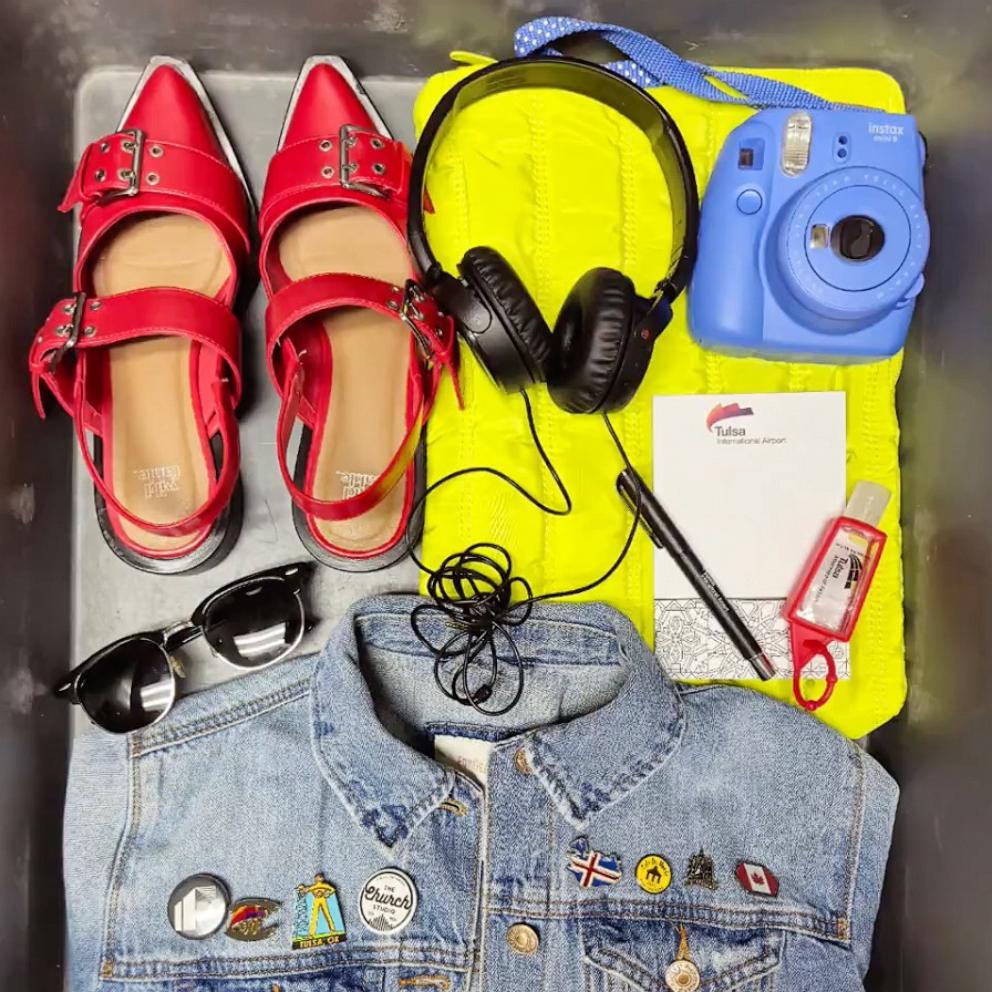
The best time to book Thanksgiving and holiday travel is coming up, plus tools and tips to save money
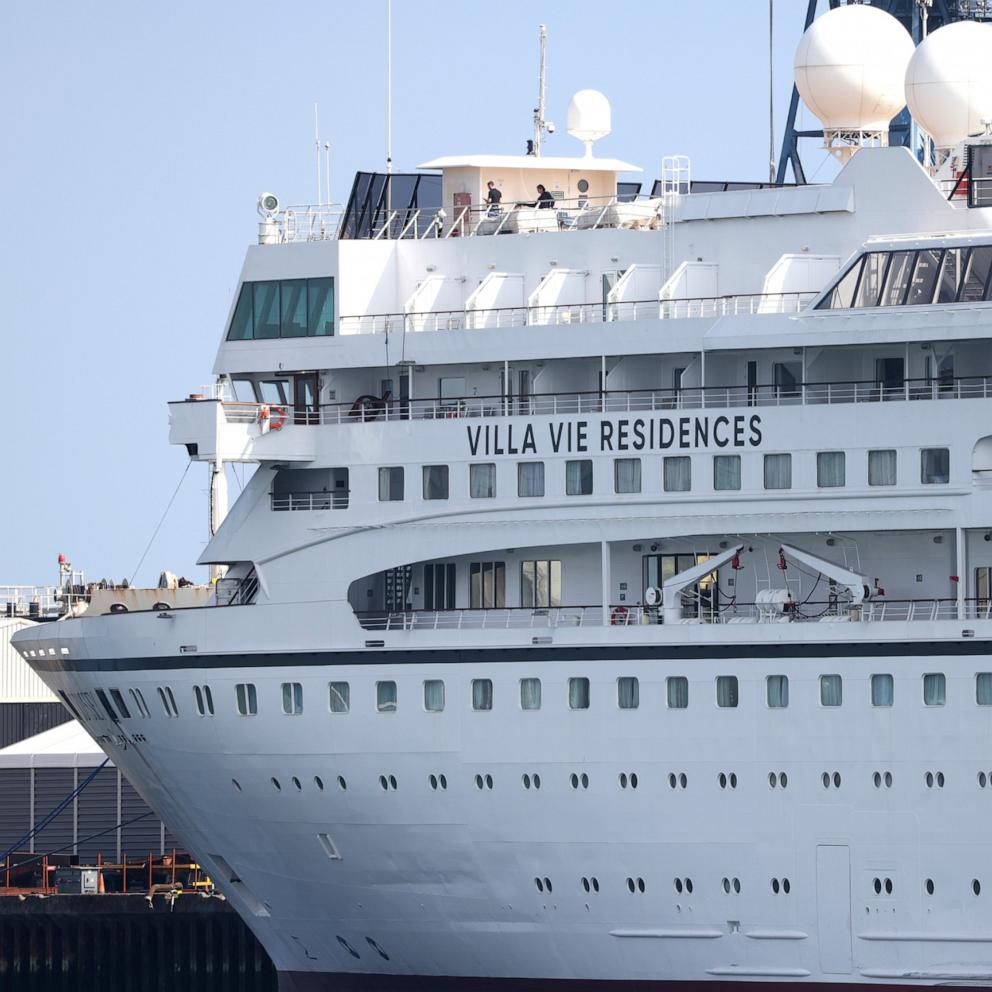
Passengers on 3-year cruise speak out as ship remains stuck in harbor
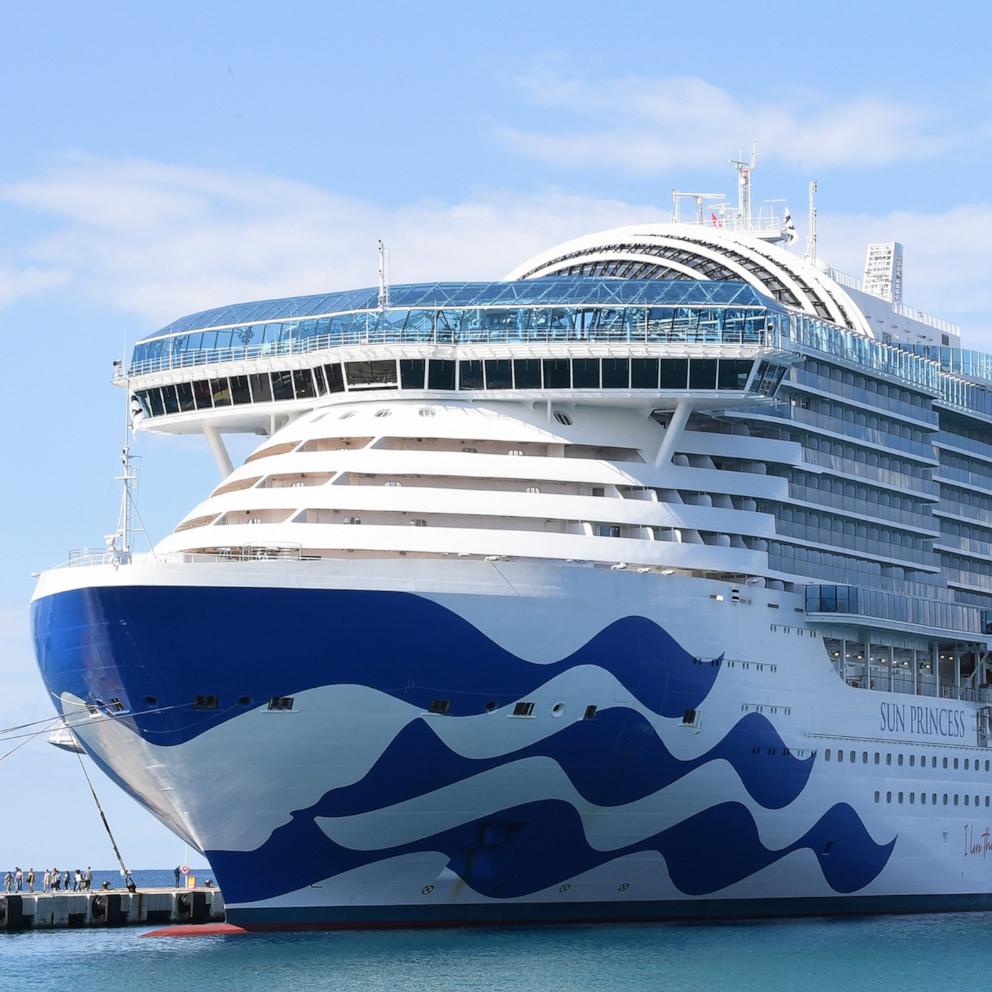
What is a crew appreciation fee? Why 1 major cruise line is raising the price
Shop editors picks, sponsored content by taboola.
- Privacy Policy —
- Your US State Privacy Rights —
- Children's Online Privacy Policy —
- Interest-Based Ads —
- Terms of Use —
- Do Not Sell My Info —
- Contact Us —
© 2024 ABC News
How 9/11 transformed air travel: TSA, security measures, and fees explained
Remembering fallen firefighters on 9/11.
343 members of the FDNY lost their lives on September 11, 2001. Victor Stagnaro, Chief Executive Officer of the National Fallen Firefighters Foundation, joined LiveNOW from FOX to discuss how his organization honors the fallen.
The September 11th tragedy undoubtedly reshaped the airline industry. Younger generations haven’t a clue about what air travel was like before the hijackings that killed nearly 3,000 people in the deadliest act of terrorism on American soil.
Even older generations may be unaware of changes, such as the history of the Transportation Security Administration and the extra fee placed on airline tickets.
Here’s how air travel was redefined in the wake of September 11, 2001.
RELATED: 9/11: The little-known story of how a small Canadian town took in thousands of stranded passengers
Security screenings
Security measures evolved with new threats, and so travelers were asked to take off belts and remove some items from bags for scanning. Things that clearly could be wielded as weapons, like the box-cutters used by the 9/11 hijackers, were banned.
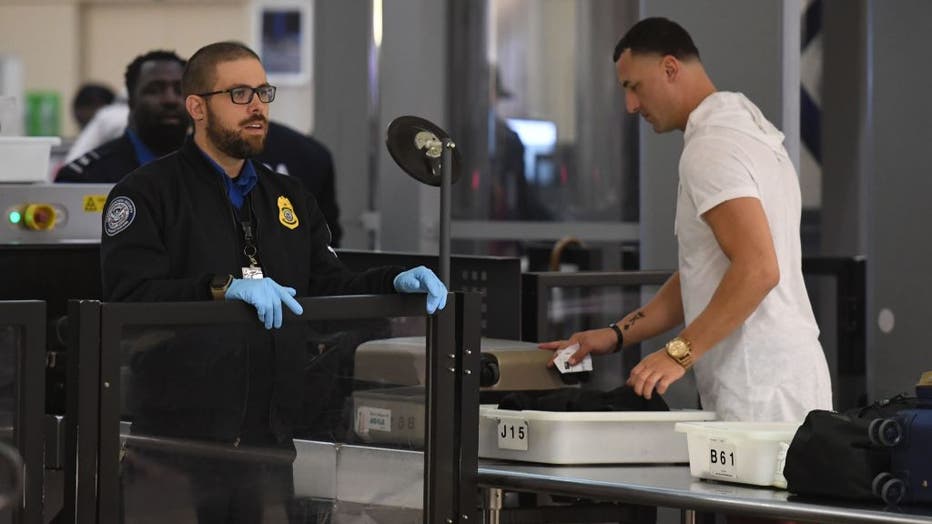
Transportation Security Administration officers (TSA) stand screen passengers at the departure area of the Los Angeles International Airport in Los Angeles, California, on 5 January, 2019.(Photo credit should read MARK RALSTON/AFP via Getty Images)
The start of the TSA, Transportation Security Administration
Two months after the attacks, former president George W. Bush signed legislation creating the Transportation Security Administration, a force of federal airport screeners that replaced the private companies that airlines were hiring to handle security.
The law required that all checked bags be screened, cockpit doors be reinforced, and more federal air marshals be put on flights. The TSA is under the Department of Homeland Security, which was also created in the wake of 9/11. It was compiled from 22 federal agencies or departments whose responsibilities ranged from Border Patrol agents on horseback to Federal Emergency Management Agency personnel inspecting damaged homes after hurricanes to Coast Guard personnel teaching boaters about marine safety.
Harris, Biden, Trump, and Vance at 9/11 ceremony
Kamala Harris, President Joe Biden, former president Donald Trump, and Sen. JD Vance put their rivalry aside to join former Mayor Michael Bloomberg at New York's Sept. 11th memorial on Wednesday.
What is the September 11th fee?
When you buy an airline ticket, you may notice the Passenger Fee, or September 11 Security Fee,
RELATED: 9/11 plotters reach plea deal over 20 years after the deadliest terrorist attack on U.S. soil
The money helps fund TSA. The fee is currently $5.60 per one-way trip in air transportation that originates at an airport in the U.S., except that the fee imposed per round trip shall not exceed $11.20, according to the TSA website.
Only travelers can pass through security, with some exceptions
Before 9/11, it was customary for friends and family to walk their loved ones to the actual gate before they boarded the plane. It was also customary for them to wait at the gate when their loved ones arrived.
With all the new security measures, only ticket holders are able to pass through security and head to the gate. There are exceptions with minors who are flying unaccompanied.
Timeline: Major events during the 9/11 terrorist attacks
The events that transpired on Sept. 11, 2001.
Some airports are allowing non-travelers to pass through security at certain times during the day, though many have since discontinued the program amid the COVID-19 pandemic.
RELATED: Toby Keith: The story behind country singer's hit 'Courtesy of the Red, White and Blue'
Philadelphia International Airport has the Wingmate Pass, which is a free amenity that gives non-ticketed guests access to the secure side of the airport. With the pass, people accompanying travelers will get to meet them at their gate.
Terminal C at Orlando International Airport is open to the public – and you don't even need a boarding pass to access all the new amenities. Approved guests can enter Terminal C with a visitor pass program that lets non-flyers say goodbye to loved ones, grab a bite or stroll through gift shops, according to a press release from MCO.
TSA officers help make air travel safe. Workers deserve protections from Congress.
The rights for the tsa workforce act would make tsos equal with other federal workers by guaranteeing crucial rights in law.
If you travel, you know the routine. Have your ID /passport ready, your shoes off, your electronics out of the bag. Check through the scanner or metal detector, pick your belongings off the conveyor belt, and head to your gate. It’s easy to forget why we do this in the first place and most of us treat going through security as just another hassle to go along with overpriced coffee and layovers.
As the Vice President for the American Federation of Government Employees Local 777, which represents Transportation Security Officers at airports across Wisconsin and Illinois, I work on behalf of the hundreds of transportation security officers who ensure that our passengers fly safely in and out of airports in those states. We take pride in on our work, and with over six million passengers flying in and out of Milwaukee Mitchell International Airport in 2023 alone, there's a lot of work to take pride in.
It’s been over twenty years since 9/11 devastated our sense of safety and security, leading to the formation of our agency in its aftermath.
TSA was created in wake of 9/11 to help keep America's skies safe
As those horrific memories slowly fade into the past, it’s easy to forget why we go through this process in the first place. If anything, the fact we haven’t experienced another attack on our skies since that dark day is a testament to the hard work of my fellow transportation security officers.
That doesn’t mean threats to passenger safety are a thing of the past, far from it. In 2023 alone, TSA officers prevented over 6,700 firearms from coming onboard commercial flights . Almost 93 percent of those firearms were loaded. Keeping our skies safe requires an experienced, knowledgeable workforce.
This is scary stuff: Project 2025 spells out second Trump term in alarming detail.
Unfortunately, since its inception, the TSA had one of the highest turnover rates of any federal agency , thanks in no small part to the lack of workforce rights that other federal workers were guaranteed.
That’s why I’m joining thousands of Transportation Security Officers across the nation in encouraging our members of Congress to cosponsor the Rights for the TSA Workforce Act .
Pay raise and recognition of rights have lowered TSA turnover
Things have improved drastically at the agency in the last two years. Officers were granted a major pay increase by Congress , our right to organize has been greatly expanded , and we just signed a majorly pro-worker contract with the agency . These changes have already had a significant impact at our agency, with turnover having decreased over 60 percent in one year.The bad news is that these changes aren’t set in stone. Most federal agencies are guaranteed Title 5 rights. These rights are legally guaranteed to the majority of federal workers. Everything from their pay scales to bargaining rights to their rights to union organization are set by law, and cannot be changed on a whim.
Interstate projects pointless: Buses and bikes beat the I-94 expansion.
We have now achieved many of the benefits of Title 5 rights, but for the over 40,000 TSA officers who protect our skies, this is a foundation built on sand. Until we’re granted full Title 5 rights, a new administrator, or new management in the White House for that matter, can unilaterally strip us of these benefits with the stroke of a pen or an executive order.
This isn’t just a call to action for our members and fellow TSA staff. The Rights for the TSA Workforce Act would make TSOs equal with other federal workers by guaranteeing these crucial rights in law. That would help continue the dramatic improvement in turnover at the agency, which means fewer gaps in staffing and faster lines for America’s air travelers. It also means less time and taxpayer money spent on recruiting and training new employees, and lastly, it means safer skies as experienced TSOs stay at the agency as opposed to leaving for greener pastures.
Here in Milwaukee, we make sure the millions of people who fly through Milwaukee Airport every year reach their destinations safely. Help us do our jobs at the best of our abilities. Tell your members of Congress and your senators to support the Rights for the TSA Workforce Act!
Debra Kluewer is Vice President of AFGE Local 777, which represents Transportation Security Officers across Wisconsin and Illinois, including Milwaukee Mitchell International Airport.
TikTokers are taking 'aesthetic' photos of their TSA trays in the latest travel trend. But not everyone's on board.
- The "TSA tray aesthetic" trend is taking over TikTok with over 16 million posts.
- Some creators are having fun with their flat lays, while others are just documenting their travel.
- Critics argue the trend causes delays at airport security, but creators say they are being mindful.

In the ever-evolving world of travel trends, it's time to say goodbye to raw-dogging — flying without devices or any other distractions — and hello to the "TSA tray aesthetic."
Gen Z's fall travel trend requires participants to conceptualize, style, and photograph their personal belongings at the TSA's airport security checkpoint before hopping on their flight.
The "TSA tray aesthetic" has been all over TikTok for the past few weeks, with over 16 million related posts drawing thousands of views.
Before her trip to Mexico, 24-year-old creator Ckalysta Hutchings made one such video, in which she artfully arranged her personal belongings in a gray bin.
In her video, she shows an iPad in a black textured case, matching headphones, a pair of sunglasses, a Rhode Beauty lip gloss on a gray iPhone cover, and a blush, which are methodically positioned.
@ckhutchings TSA airport bin pics ft all my @rhode skin favs 🫶🏼🧖🏻♀️✈️ #pinterestaesthetic #microinfluencer #contentcreator #microinfluencertips #traveltiktok ♬ Apple - Charli xcx
"We just got a bin and snapped a few photos in under 10 minutes," Hutchings told Business Insider, emphasizing that she and her sister had only done so "after we had gone through security."
Like many other people her age, Hutchings uses Pinterest to plan her trips. From outfits and accessories to aesthetically arranging her airport security bins, everything is conceptualized in advance. She thinks of it as a way of organizing her life and planning for what's next.
Not everyone can creatively thrive under airport security pressure, though. Some, like Vicki Rutwind, a former lawyer turned travel content creator, prefer photographing in the comfort of their home. That meant purchasing a plastic security bin before travel to keep up with the trend.
"I created my video all in one afternoon in my kitchen. I am not a put-together person at the airport, and I fly a lot," Rutwind told BI.
@vickirutwind My TSA trays based on which destination I’m traveling to. Which is your favorite? 💙 Santorini, Greece 🍋 Positano, Italy 🥐 Paris, France 🌸 Hawaii, USA (Products from P448 + @NARS Cosmetics + @elfcosmetics + @OtterBox + @dolceitalianaoriginal were gifted by those brands) #travelaesthetic #pinterestaesthetic #travelstyle #travelinstyle #packingideas #pinterestaesthetic ♬ original sound - 🐈⬛
A travel ritual before it turned into a viral trend
The practice isn't totally new, though. When Emily Abbate, a former magazine editor and current podcast host of Hurdle , began traveling a lot for work in 2015, she wanted a unique and quick way to capture her adventures.
That's when she turned to airport bins and began putting together flat lays.
"I started throwing a few things into my bag before I would travel that would be indicative of where I was heading," she told BI, adding that she only took photos after going through security and taking her tray off to the side.
Her items included a mix of practical products, such as a Lonely Planet book on Paris when she attended the Paralympics , or a pair of sneakers if she collaborated with a particular brand.
Abbate saw this as a fun way to commemorate her travels. "I found it really fun to look back at [them] end of the year and have a personal scrapbook of all the cool places that I had been to," she said.
View this post on Instagram A post shared by Emily Abbate (@emilyabbate)
Rutwind also considers it a unique way to relive her travels. Upon seeing the trend, she ordered a $17 bin on Amazon — which doubles as a storage bin — and then styled it using different colorways representing destinations and products, such as a pair of red sneakers and matching NARS lipstick for Paris or a pair of blue Adidas and matching knitwear for Santorini.
Related stories
Some lifestyle brands and creators are monetizing this trend
From fashion label Reiss to publishing house Faber, brands have participated in the trend by showcasing a collection of products — books, mules, designer knitwear, or claw clips — that would be part of their "airport aesthetic."
"This trend specifically aligned perfectly for us, curating an aesthetic selection whilst focusing on our travel-friendly products," storage solutions brand Stackers told CNN .
@mystackers What the Stackers marketing team’s airport security trays look like this Summer… whos tray is your vibe? 👀 airporttray whatsinmybag packing summerpacking summeraesthetic ♬ Angel Of My Dreams - JADE
Lifestyle content creators , like Symphani Soto, have also used the microtrend to boost their personal brands, arranging everyday essentials she uses and linking them to their LikeToKnow.It or LTK , an e-commerce platform that allows creators to share and sell products from partner brands.
"It's just a fun way to curate what I actually use every day and share with people; if they want to purchase something like a lipstick or a bag, for instance, they can automatically go over there and purchase it," Soto told BI.
Not everyone is on board with the trend
When Caleb Harmon-Marshall, a former TSA agent , started receiving calls from his old co-workers stating that several people at the airport were holding up the lines to take photos of their bins, he knew he had to say something.
Since leaving his job, Harmon-Marshall has run a travel newsletter, Gate Access , which focuses on passengers' flight and security rights. So he decided to make a video and "not tell people not to do it, but just be mindful of the people behind you," he told BI.
Harmon-Marshall isn't the only one to flag this. Several news outlets have reported that some influencers have made what's already an annoying part of traveling even worse by holding up the lines.
Creators who spoke to Business Insider emphasized they would never hold up the security line or encourage their followers to do so.
A TSA representative told BI they're aware of the trend and that "as long as the staged glamor photos are not causing delays or issues with other passengers in the checkpoint, there are no issues."
The spokesperson added that people who wish to snap their bins should do so after they've crossed security and that "setting up a bin 'just so' for that ideal social media photo might take a minute or two, so best to go through the security checkpoint and take the photo afterward. At that point, take all of the time you want to set up the bin."
As with most online fads , this one has received strong and mixed reactions from people online.
Hutchings said she had a series of hate comments on her video, but what really matters is "how you, as an individual, feel about your feed."
The cute photos she uploads make her happy and hopefully inspire others, so, she said, "at the end of the day, if it's not for you, keep scrolling."
Watch: Why the retail industry has its eye on Gen Z
- Main content

An official website of the United States government
Here’s how you know
Official websites use .gov A .gov website belongs to an official government organization in the United States.
Secure .gov websites use HTTPS A lock ( Lock A locked padlock ) or https:// means you’ve safely connected to the .gov website. Share sensitive information only on official, secure websites.
TSA is prepared for Thanksgiving travel and dishes on what foods can be carried through security checkpoints and what items need to be transported in checked baggage
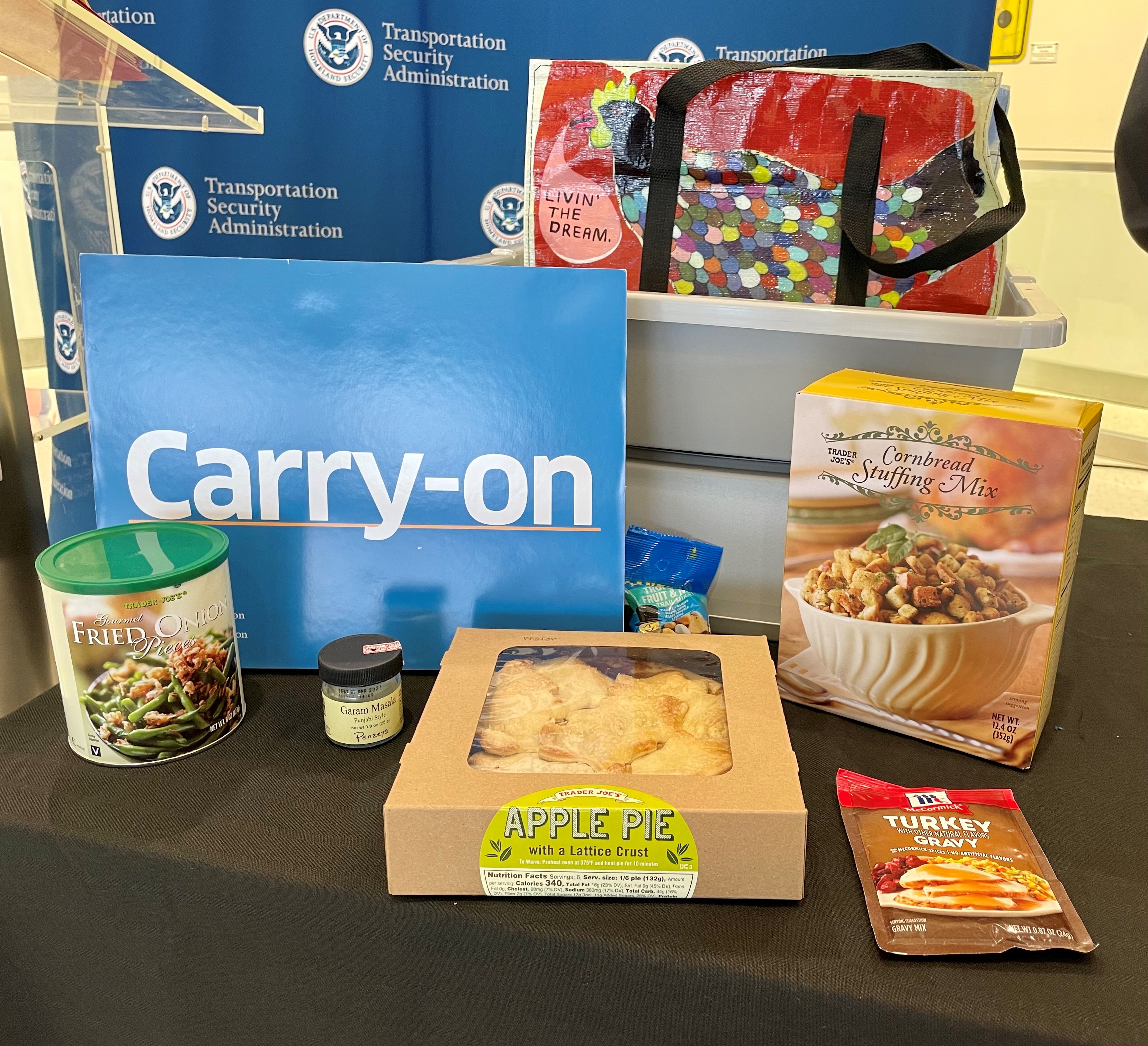
The Transportation Security Administration (TSA) is prepared for Thanksgiving travel and expects to screen more than 30 million passengers during the 12-day Thanksgiving holiday period, which kicks off this Friday, Nov. 17, and concludes on Tuesday, Nov. 28. Historically, the three busiest travel days are the Tuesday and Wednesday prior to Thanksgiving and the Sunday afterward.
But before you agree to bring a family favorite food item to contribute to the Thanksgiving holiday table, it’s important to think about how you’re planning to transport it if you are flying to spend the holiday with family or friends. Most foods can be carried through a Transportation Security Administration (TSA) checkpoint, but there are some items that will need to be transported in checked baggage.
Here’s some food for thought. If it’s a solid item, then it can go through a checkpoint. However, if you can spill it, spread it, spray it, pump it or pour it, and it’s larger than 3.4 ounces, then it should go in a checked bag.
Food items often need some additional security screening, so it is best to place those items in an easily accessible location of the carry-on when packing them and then removing those items from your bag and placing them in a bin for screening at the checkpoint.
Unsure if an item should be packed in a carry-on bag, checked bag, either or neither? Download the free myTSA app , which has a handy “What can I bring?” feature that allows you to type in the item to find out if it can fly. Or ask on Twitter or Facebook Messenger at @AskTSA . Travelers may send a question by texting “Travel” to AskTSA (275-872).
Here are examples of the most commonly asked questions about which food items are permissible through a checkpoint and which ones need to get packed in checked baggage. It is also important to remember food safety by storing the food properly while traveling to prevent foodborne illness. If you need to keep items cold during your trip, ice packs are permissible, but they must be frozen solid and not melted when they go through security screening. Additionally, the U.S. Food and Drug Administration also has recommendations on holiday food safety.

- Baked goods. Homemade or store-bought pies, cakes, cookies, brownies and other sweet treats.
- Meats. Turkey, chicken, ham, steak. Frozen, cooked or uncooked.
- Stuffing. Cooked, uncooked, in a box or in a bag.
- Casseroles. Traditional green beans and onion straws or something more exotic.
- Mac ‘n Cheese. Cooked in a pan or traveling with the ingredients to cook it at your destination.
- Fresh vegetables. Potatoes, yams, broccoli, green beans, Brussels sprouts, cauliflower, beets, radishes, carrots, squash, greens.
- Fresh fruit. Apples, pears, pineapple, lemons, limes, cranberries, blueberries, strawberries, bananas, kiwi.
Thanksgiving foods that should be carefully packed with your checked baggage
- Cranberry sauce. Homemade or canned are spreadable, so check them.
- Gravy. Homemade or in a jar/can.
- Wine, champagne, sparking apple cider.
- Canned fruit or vegetables. It’s got liquid in the can, so check them.
- Preserves, jams and jellies. They are spreadable, so best to check them.
- Maple syrup

IMAGES
VIDEO
COMMENTS
Inform the TSA officer at the beginning of the screening process that you are carrying formula, breast milk, toddler drinks, and baby/toddler food (to include puree pouches) in excess of 3.4 ounces. Remove these items from your carry-on bag to be screened separately from your other belongings. TSA officers may need to test the liquids for ...
Call TSA Cares 72 hours prior to traveling with questions about screening policies, procedures and what to expect at the security checkpoint. You may also call to request assistance at the checkpoint. ... Formula, breast milk, toddler drinks and baby/toddler food (to include puree pouches) in quantities greater than 3.4 ounces or 100 ...
2. Bring enough canisters - and store them safely. Just as you would for a plane ride, you'll want to bring enough formula to last the entire trip (or have a plan for sourcing more after you arrive). "It's good to be well-stocked in case your usual brand is not easily available at your destination," says McDermott.
The TSA is sensible enough to know that parents traveling need to always be able to bottle feed their baby and so baby formula is considered medically necessary. Quantities greater than 3.4 ounces are permitted for liquid baby formula, and their is no limit on how much powdered baby formula you can bring. You can even bring water for babies too!
TSA regulations make generous allowances for milk and formula: Formula, breast milk, toddler drinks, and baby/toddler food (to include puree pouches) in quantities greater than 3.4 ounces or 100 ...
Formula, breast milk, juice, and baby foods in quantities greater than 3.4 ounces [100mls] are allowed in carry-on baggage and don't need to fit in a quart-sized bag. According to Transport Security Administration [TSA] guidelines, you're permitted to bring larger amounts of breast milk and baby formula in reasonable quantities for your trip.
Formula, breast milk, juice in quantities greater than 3.4 ounces or 100 milliliters are allowed in carry-on baggage and do not need to fit within a quart-sized bag. Remove these items from your carry-on bag to be screened separately from the rest of your belongings. You do not need to travel with your child to bring breast milk. Breast milk and formula are considered medically necessary liquids.
1. Security Regulations and Restrictions: Security measures are paramount in air travel. Be prepared for your baby formula to undergo additional screening procedures at security checkpoints. Inform the TSA officers that you're carrying baby formula, whether it's ready-to-feed formula, powdered formula, or breast milk. These liquids will ...
Liquid amounts. For baby food including breast milk, water for formula, liquid formula, juice, and other forms of milk, you're allowed to bring "a reasonable amount" of each above the 100ml/container limit. The amount that is reasonable to take through security is left up to the TSA officer. I have actually run into issues with this when ...
Yes, you can bring baby formula on a plane. Baby formula is one of a few liquids that does not need to follow the TSA's 3-1-1 rule. You are allowed to bring more than 3.4 ounces of baby formula on a plane and it does not need to fit in one-quart sized bag. Also, you can bring baby formula in your carry-on even if your child is not on the ...
Traveling with a baby can be challenging, especially when it comes to handling their feeding needs. Fortunately, the Transportation Security Administration (TSA) has specific guidelines to make flying with baby formula, breast milk, and baby food easier and stress-free. Here's a comprehensive guide for parents and guardians to navigate these rules with ease. Understanding TSA Guidelines for ...
TSA liquid limits don't apply to breastmilk. Although the TSA has a very small limit on the amount of liquids you can bring on a plane. The 3.2-ounce rule does not apply to breastmilk, liquid formula, or baby food. You can actually bring large quantities of these liquids through airport security.
Liquid Rule Exemption for Baby Food on Planes. Typically, the permitted quantity of liquids that you can carry on a plane is 3.4 ounces (100 milliliters). But when it comes to baby food, this is often not nearly enough for a full flight. Thankfully, the TSA understands this and allows you to travel with as much as you need.
What are the TSA guidelines for traveling with baby formula? The TSA has specific guidelines for traveling with baby formula. Parents or guardians are allowed to bring a reasonable amount of formula through the security checkpoint, even if it exceeds the 3.4-ounce liquid limit.
The TSA termed formula and breastmilk as "medically necessary liquid and gels," and fortunately, they allow liquids exceeding 3.4 ounces or 100ml when you are traveling with an infant. You may need cooling packs or other cooling accessories to preserve the baby food while on a journey.
The TSA classifies baby formula as medically necessary, so you can pack as much baby formula as you need for the trip without being limited to the 3.4-ounce rule that applies to other liquids. When you go through security screening, inform airport security of the amount of baby formula you're carrying. Remove the formula from your carry-on so ...
The first important thing to know about traveling with baby formula is that you are exempt from the normal hand baggage liquid rules which limit liquids at 100ml. Sometimes this is known as the 3-1-1 rule. This is only valid IF you are flying with an infant. You can also take formula in your hold luggage.
TSA Rules For Flying With Baby Formula. Traveling with a baby can be stressful, especially when it comes to navigating airport security with their essentials like baby formula. However, the Transportation Security Administration (TSA) has rules in place to make sure that baby formula is allowed on board planes without any issues.
Formula-feeding while road tripping gets easier the more times you do it, especially when you have the right strategies in place to keep your baby happy with a full tummy. Prepare Bottles Ahead - This tip we recommended for plane travel works great for car travel as well. Because it's so important to have clean hands to prepare bottles, it ...
The good news is that the TSA allows travelers to pack baby formula, toddler drinks, breast milk, and baby food in any amount. Usually, passengers can bring only 3.4 ounces (100ml) of liquid in their carry-on bags. But that's not the case with baby formula. The TSA considers baby formula medically necessary liquids. That's why there's no ...
Remove the formula items from your carry on to be screened separately. Let the TSA officer know that you have formula in larger amounts than 3.4 ounces. The TSA may need to test the formula for prohibited items (by pouring a very small amount out). If you do not want the formula bottle to be opened, let the TSA know and additional screening ...
For many people, going through TSA screening at the airport is a panicked jumble of taking shoes off and getting laptops out. But a recent viral trend on Instagram and TikTok has travelers pausing for a moment to snap a photo of their artfully arranged TSA bins and share their airport tray aesthetics.. The gray Transportation Security Administration bins shared on social media display items ...
Breast Milk. Carry On Bags: Yes (Special Instructions) Checked Bags: Yes. Formula, breast milk, toddler drinks, and baby/toddler food (to include puree pouches) in quantities greater than 3.4 ounces or 100 milliliters are allowed in carry-on baggage and do not need to fit within a quart-sized bag. Formula, breast milk, toddler drinks, and baby ...
The September 11th attacks profoundly changed air travel. Prior to 2001, security protocols were less stringent, allowing friends and family to accompany passengers to the gate. Post-9/11 ...
TSA was created in wake of 9/11 to help keep America's skies safe As those horrific memories slowly fade into the past, it's easy to forget why we go through this process in the first place.
If it is not received within the 10-day period, applicants have 60 days to report non-receipt of the card by visiting the TSA Enrollment website or calling (855) 347-8371 weekdays from 8 a.m. to 10 p.m. ET. Failure to report non-receipt of the card within 60 days will result in a $60 fee to replace the lost card.
Enjoy the same great TSA PreCheck benefits you know and love, now with new enrollment options. Enjoy a smoother security screening process with ... Renew through CLEAR and you may qualify for discounts on other CLEAR travel products. Renew online for $68.95; Renew in-person for $77.95; RENEW. Additional TSA Resources.
The "TSA tray aesthetic" trend is taking over TikTok with over 16 million posts. Some creators are having fun with their flat lays, while others are just documenting their travel. Critics argue ...
WASHINGTON — As airline passengers prepare to take to the skies this Independence Day holiday, the Transportation Security Administration (TSA) is prepared for a sustained period of high passenger volumes. TSA expects to screen more than 32 million individuals from Thursday, June 27 through Monday, July 8, which is a 5.4% increase over 2023 Independence Day holiday travel volumes.
The Transportation Security Administration (TSA) is prepared for Thanksgiving travel and expects to screen more than 30 million passengers during the 12-day Thanksgiving holiday period, which kicks off this Friday, Nov. 17, and concludes on Tuesday, Nov. 28. Historically, the three busiest travel days are the Tuesday and Wednesday prior to Thanksgiving and the Sunday afterward.